#to be clear this is specifically about about *early* Anglo-Saxon England
Explore tagged Tumblr posts
Text
“The condition of the dowager queen in early Anglo-Saxon England seems less secure than among the Franks, but this appears to result from political implications rather than loss of the dignity of queenship. There were few active queen-regents, but the mature succession and semi-elective nature of Anglo-Saxon monarchy virtually eliminated this avenue of occupation for a king's widow.”
Julie Anne Smith, Queen-Making and Queenship in Early Medieval England and Francia / Stefany Wragg, Early English Queens, 650-850: Speculum Reginae
"Several mothers of kings were influential [in early Anglo-Saxon England] but examples of queens serving as regents seem rare […]. This is a major difference from, for example, Frankish queens, because of the nature of early English kingship. Frankish kings were more strictly patrilineal, descending in the first instance from father to son and, only in their absence, then to other male relatives. Kingship in early England, on the other hand, derived from two major principles. Firstly, a candidate for the throne had to be a male descended from the royal stock, usually with a mythic progenitor. Secondly, he had to be a proven and effective military leader. There are almost no examples of kings younger than their late teens. Ecgfrith of Mercia [son of Offa and Cynethryth] is a notable counterexample, but the circumstances of his accession were remarkable […]. Queens in early England, then, were sometimes mothers, though rarely continued as dowager queens, but were always defined by their close proximity to kings."
#anglo-saxons#english history#queenship tag#my post#to be clear this is specifically about about *early* Anglo-Saxon England#and there were exceptions (Cynethryth and Seaxburh of Ely; Seaxburh of Wessex who seems to have ruled in her own right; etc)#But regents for minors become a far more notable and prominent feature from the late 10th century#mainly beginning with Aelfthryth who functioned as regent for her son Ethelred#and whose role paved the way for Emma of Normandy#(Eadgifu is often viewed as a regent but this is misleading: her sons were adults. She was powerful but she wasn't ruling for them)#queue
26 notes
·
View notes
Note
you’re attacking that neopagan kind of birthstone post about druid plants, but could you please elaborate or at least clarify the explicit trope that is being used that has been historically weaponized?
I used to spend about a good third of my time on this godforsaken website attacking that idea, but sure, I'll do it again. This will be a bit of an effortpost, so I'll stick it under the readmore
There is a notion of 'celts' or Gaels as being magicial and somehow deeply in touch with nature and connected to pre-Christian worldviews that the people who decided to make up the "Celtic tree astrology" used. This is also why Buffy used Irish Gaelic as the language of the demons, why Warhammer uses Gaelic as Elvish, why garbled Scottish Gaelic is used by Wiccans as the basis for their new religious construct, why people call themselves Druids to go an say chants in bad Welsh in Stonehenge, or Tursachan Chalanais, or wherever, etc etc. This stuff is everywhere in popular culture today, by far the dominant view of Celtic language speaking peoples. Made up neopagan nonsense is the only thing you find if you go looking for Gaelic folklore, unless you know where to look, and so on and so on. I could multiply examples Endless, and in fact have throughout the lifespan of this blog, and probably will continue to.
To make a long history extremely brief (you can ask me for sources on specifics, or ask me to expand if you're interested), this is directly rooted in a mediaeval legalistic discussion in Catholic justifications for the expansionist policies of the Normans, especially in Ireland, who against the vigourous protestation of the Church in Ireland claimed that the Gaelic Irish were practically Pagan in practice and that conquest against fellow Christians was justified to bring them in like with the Church. That this was nonsense I hope I don't need to state. Similar discourses about the Gaels in Scotland exist at the same time, as is clear from the earliest sources we have postdating the Gaelic kingdom of Alba becoming Scotland discussing the 'coastal Scots' - who speak Ynglis (early Scots) and are civilised - and the 'forest Scots' (who speak 'Scottis' (Middle Gaelic) and have all the hallmarks of barbarity. This discourse of Gaelic savagery remains in place fairly unchanged as the Scottish and then British crowns try various methods for integrating Gaeldom under the developing early state, provoking constant conflict and unrest, support certain clans and chiefs against others and generally massively upset and destabilise life among the Gaels both in Scotland and Ireland. This campaign, which is material in root but has a superstructure of Gaelic savagery and threat justifying it develops through attempts at assimilation, more or less failed colonial schemes in Leòdhas and Ìle, the splitting of the Gaelic Irish from the Gaelic Scots through legal means and the genocide of the Irish Gaels in Ulster, eventually culminates in the total ban on Gaelic culture, ethnic cleansing and permanent military occupation of large swathes of Northern Scotland, and the destruction of the clan system and therefore of Gaelic independence from the Scottish and British state, following the last rising in 1745-6.
What's relevant here is that the attitude of Gaelic barbarity, standing lower on the civilisational ladder than the Anglo Saxons of the Lowlands and of England, was continuously present as a justification for all these things. This package included associations with the natural world, with paganisms, with emotion, and etc. This set of things then become picked up on by the developing antiquarian movement and early national romantics of the 18th century, when the Gaels stop being a serious military threat to the comfortable lives of the Anglo nobility and developing bourgeoise who ran the state following the ethnic cleansing after Culloden and permanent occupation of the Highlands (again, ongoing to this day). They could then, as happened with other colonised peoples, be picked up on and romanticised instead, made into a noble savage, these perceived traits which before had made them undesirable now making them a sad but romantic relic of an inexorably disappearing past. It is no surprise that Sir Walter Scott (a curse upon him and all his kin) could make Gaels the romantic leads of his pseudohistorical epics at the exact same time that Gaels were being driven from their traditional lands in their millions and lost all traditional land rights. These moves are related. This tradition is what's picked up on by Gardner when he decides to use mangled versions of Gaelic Catholic practice (primarily) as collected by the Gaelic folklorist Alasdair MacIlleMhìcheil as the coating for Wicca, the most influential neo-pagan "religion" to claim a 'Celtic' root and the base of a lot of oncoming nonsense like that Celtic Tree Astrology horseshit that started this whole thing, and give it a pagan coat of paint while also adding some half-understood Dharmic concepts (three-fold law anyone?) and a spice of deeply racist Western Esotericism to the mix. That's why shit like that is directly harmful, not just historically but in the present total blotting out of actually existing culture of Celtic language speakers and their extremely precarious communities today.
If you want to read more, I especially recommend Dr. Silke Stroh's work Gaelic Scotland in the Colonial Imaginary, Dr. Aonghas MacCoinnich's book Plantation and Civility in the North-Atlantic World, the edited collection Mio-rún Mór nan Gall on Lowland-Highland divide, the Gaelic writer known in English as Ian Crichton Smith's essay A real people in a real place on these impacts on Gaelic speaking communities in the 20th century, Dr. Donnchadh Sneddons essay on Gaelic racial ideas present in Howard and Lovecrafts writings, and Dr. James Hunter's The Making of the Crofting Community for a focus on the clearings of Gaels after the land thefts of the late 18th and early 19th century.
@grimdr an do chaill mi dad cudromach, an canadh tu?
283 notes
·
View notes
Text
So something has been bugging me for a while now about A and N’s backstories, and while I know not everyone will be as pedantic as me, as someone who loves history and has done a lot of writing, I feel that if you’re going to write a story about vampires and give them a specific time and date of origin, then there should be a certain level of research that goes into making that background authentic. I'm not saying that Mishka didn’t do any research. It just seems that in order to keep the vibe of a happy, mellow fantasy some of the less savoury aspects of A and N’s upbringings have been left out, and it's a shame. To be honest, it feels a bit disingenuous, and it feels like an opportunity got wasted.
Let me explain (long post got long, it's 2am)
Let's take A first, since the problem is simpler here.
A is the child of a Norman lord and an Anglo-Saxon noblewoman, born in the first generation after the Norman Conquest of England in 1066. A says that these were turbulent times but that their parents had a happy marriage. Which. While I’m sure a lot of unions in that time period made the best of it, I can’t help but feel this description strips away a lot of the context of what was going on at that point in history - and removes some of the complexity about A’s thoughts on love and relationships.
Basically, after he took control of the throne, William the Conqueror stripped many Anglo-Saxon lords of their lands and titles so he could give them to his Norman buddies instead - with the added bonus that it left the Anglo-Saxons without the means to raise armies against him. The sisters, daughters, and widows of the dispossessed Anglo-Saxons were then forced to marry these new Norman lords to legitimise their power, not infrequently after all of their male relatives had been slaughtered. It’s not as if Anglo-Saxon women weren’t used to being used as political chess pieces, but the years after the conquest were brutal. It’s why William had to build so many castles. The point that I’m trying to make is that even if A’s mother was content enough in her daily life, due to the power imbalance between her and her husband, it's very likely she had little choice in the matter. She may have seen a lot of her family killed for political reasons, with the knowledge that – in an age where women had very little protection outside of their paternal household – she might be next if she made too much of a fuss.
It would be fascinating to see what effect that tension has had on A 900 years later, or even to get an acknowledgement of how much times have changed, but we don’t. We don't see how their early years affected them, how they view relationships formed naturally instead of via political contracts. And I really, really wish we did. There is so much potential there.
But A is not the one keeping me up past 2 in the morning. It’s N, and the utter detachment their backstory seems to have from the period in history they lived in as a human. And it all stems from the fact that they came from the English nobility in the late 1600s.
See, the bulk of the problem is that English inheritance law at the time heavily favoured primogeniture, where a man’s wealth would go to his first-born son. Some dispensation was made for widows and other children, but the estates, assets, and most of the money had a very clear destination.
For one thing, this makes it kinda weird that N’s stepfather would have needed an heir before he could inherit, because except in extreme circumstances everything would have gone to him anyway. Don't get me wrong, this isn't the worst part of the problem, it’s just annoying when there are more plausible reasons for him marrying a woman already pregnant with another man’s child (old family friend wanting to save her from disgrace, needed the dowry to pay off gambling debts, there was a longstanding betrothal between them that would have been tricky to get out of, etc.).
No, the bigger problem with N’s backstory vs primogeniture is firstly that at the time the English aristocracy was racist af (still is tbh) and given his pretty obvious mixed-race heritage, no court would have agreed that Nate was a legitimate son (this is for a very special reason that we will be coming back to). I say Nate specifically here because primogeniture requires the eldest legitimate son. Nat wouldn’t have inherited at all, as women in that period passed from the guardianship of their father (or other male blood relative) into that of their husband after marriage, and only gained any kind of independence with widowhood. If N had been an only child, maybe they would have been treated as a special case, but unfortunately Milton exists: the eldest legitimate son who by law will inherit everything.
Now here’s the thing. Your average aristocrat in the 17th century is very obsessed with lineage and keeping the family line unbroken. He would not, therefore, send his legitimate heir to sea to be shot at or drowned before he can carry on the family name – that joy instead goes to any other sons who need their own profession, because again, they will get very little. Nat would have had a dowry, but would never have been expected to make her own living, so I'm going to focuson Nate for this next bit.
In Book 3, if you unlock his tragic backstory Nate tells you he joined the Royal Navy after Milton went missing so that he could go look for him. And, well. This is where his backstory as Mishka tells it completely falls apart. For two reasons:
1. Even in the modern day, you can’t ‘just’ join the Navy, and you certainly can’t just jump straight to being a lieutenant – it takes years of training and after a certain age they won’t take you because they won’t be able to mould you easily enough into a useful tool. For most of the Navy's history, the process was even more involved. It wasn’t an office job you could just rock up to and then quit if you felt like it, it was a lifetime commitment. Boys destined to be officers would be sent to sea as early as 12 to learn shipboard life, starting at the bottom and moving up the ranks. These were gained by passing exams and by purchasing a commission – which is why you generally had to come from wealth to be an officer at all. Once you get to lieutenant you're responsible for a lot of people, and might be tasked with commanding any captured ships alongside the daily running of yours - it was not an easy job.
2. Even as a lieutenant (one rank below Captain, with varying levels of seniority) it’s not like you can just go where you want. In the 1720s British colonies already existed in India, the Caribbean, and up the entire eastern seaboard of North America and into Canada, and the Navy was tasked with protecting merchant shipping along these seaways (and one trade in particular that we’ll be getting to, don’t worry). Nate could have ended up practically anywhere in the burgeoning empire. He would not have been able to choose whom he served under, and would not have been able to demand his superior officer go against orders from the admirality to chase down one lone vessel because he thinks another one of the admirals might be a bit dodgy. It could not have happened.
Besides these impracticalities, there’s a far easier way for the child of a wealthy man to get to a specific point on the far side of the globe to look for their lost sibling, which is the route I assume Nat took sine she couldn’t have joined the Navy (yes she could have snuck in but she’s specifically in a dress in the B2 mirror scene so). All they'd have to do would be to charter a ship and tell the captain where to go, which is the plot of Treasure Island. It's quicker, less fuss, with less chance of things going wrong. It's even possible in the age of mercantilism that the Sewells had some merchant vessels among their holdings that could be diverted for the task. Why go through the hassle of joining the Navy and potentially ending up on the wrong side of the world when you can just hire a ship directly?
If Nate does have to be in the Navy (and let’s face it, it’s worth it just for the uniform) then it's far more plausible is that, as the illegitimate son who would not inherit because of racism etc, he got sent to the Navy as a boy and rose through the ranks to become a lieutenant. When he got news of Milton’s disappearance not far from where he was stationed, he begged his captain to go investigate in case whatever happened turned out to be the symptom of a bigger problem. Like pirates.
I like this version better not just because it makes more sense, or because it keeps Nate’s situation re: inheritance closer to Nat’s and therefore makes their stories more equal, but also because it adds a delicious amount of guilt to Nate’s need to find his brother. We know his entire crew died looking for answers, because he was selfish – that’s roughly 100-400 lives lost because of him, and we know that sort of thing eats at him.
So that's one side of the story, but if Milton wasn’t in the Navy, what was he doing on the other side of the Atlantic in the first place? Well, this is where we come to the biggest elephant in the room regarding N’s backstory as a member of the 17th century English aristocracy and potentially as a naval officer: the Atlantic Slave Trade. If you are wealthy in 17th century Britain it's more than likely that your wealth comes either from the trade itself, or from the products made with the labour of enslaved people. If you are wealthy, you want to protect your assets from attack by pirates or foreign powers so you don't become less wealthy, and that is what the Navy is for.
Regardless of N’s own views on slavery at the time – and any subsequent changes in opinion – it’s likely their family owned or had shares in slave plantations in the Americas. As distasteful as it is, it makes far more sense that Milton was on a trip to check the family’s holdings when his ship - specifically a merchant vessel - went missing. From a pirate perspective, a merchant ship would make a much better target than a Navy vessel, being slower, more likely to have valuable cargo, and less likely to have marines or a well-trained broadside.
It's not surprising that Mishka left out the subject of the slave trade given her tendency to skirt around darker subjects and general blindspot for racial politics, but it is nuance that, if it was there, would create a more grounded and coherent backstory for N that doesn’t have quite so many holes. Like with A being the child of an invader and his war bride, we could get some deeper thoughts from N about their place in the world - How do they feel to have grown up so privileged when others who looked like them were regarded as literal property? How did they feel being part of the system that made it happen? Did it inform their compassionate nature? Is it still a source of guilt or someithng they've tried to make up for?
I'm not sure where I was going with all of this. It's late, my sleep pattern is fucked. The tl;dr is that giving the vampires' backstories historical context would make them feel more multifaceted and would give opportunities for character growth that are instead missed because of a desire for a more sanitized version of the past.
#thank you for coming to my ted talk#the wayhaven chronicles#twc#a du mortain#adam du mortain#ava du mortain#n sewell#nate sewell#nat sewell#it's annoying because it’s such a small tweak in the grand scheme of things#If she didn’t want unfortunate implications she could have made N from a century later when the navy was actively trying to stop slavery#A could have been from a 50 years earlier to tie his whole family’s demise into the subjugation of the english after the battle of hastings#or a century later when the two courts had mostly integrated#mishka made choices#they deserve to be given more substance than mere aesthetics#you can tell it’s late I’m using long words
239 notes
·
View notes
Text
TOLKIEN, MYTH AND THE EARLY 20TH CENTURY
A week ago I wrote a post about my excitement in discovering just how much Tolkien took inspiration from Anglo-Saxon poetry.
I was so lost in my little over-emotional bubble that I was genuinely a little surprised when a few people expressed their disappointment in discovering that "The Lord of The Rings" wasn't wholly original. It makes sense, though, so I thought I'd address it.
These are @fortunes-haven ' s tags:

@sataidelenn already wrote an interesting reply, but I'd like to approach the question from a different point of view. Why? Because the first thing I thought about when reading this comment was how I myself have grumbled under my breath about having to wade through someone's "personal mythology smoothie", only I wasn't reading Tolkien. I was reading T. S. Eliot.
Now, I want to preface this by making it clear that I am well aware Tolkien is by no means a modernist. He did, however, write LOTR in England in the late 30s. He was part of the same culture, the same society, and above all the same historical context that produced "The Waste Land" and "Ulysses", and I think we should take that into account when we discuss his work.
Because by the time Tolkien published LOTR, Joyce and Eliot and Yeats had already discussed and applied the mythic method. Was Tolkien aware of their debates? Did he read and appreciate their books? I have no clue. It would take some research to find out, research I currently (unfortunately) don’t have time for. But I do not think it a stretch to suggest that Tolkien might have been moved by the same need that drove other writers to look back at myth, although in very different ways.
Why did Joyce and Eliot feel compelled to return to the narrative roots of mankind? Why did Yeats devote so much time to Celtic lore? Why did Tolkien write a new epic and base it on the Saxon world?
The answer is the same: because they lived at the start of a century that posed more questions than ever, but provided no answers; a century when time and the human mind and the very structure of matter had ceased to be solid, defined, a foundation to rely on; a century torn apart by brutal, inhumane, sensless war.
When you can't find answers in the present and the future is so uncertain it's laughable, you look to the past. Because the thing is, we can talk about "personal mythology" all we want, but myths are never personal. They are universal. They are tied to a specific cultural context, certainly, but they exemplify emotions, truths and tragedies that are common (or supposed to be common) to all humankind, beyond space and time. Myths are supposed to be eternal.
They are also a very effective shorthand to communicate rather complex concepts.
I can write five pages telling my girlfriend that she makes me feel safe, that she is something I've longed for and fought to gain, something I've dreamed about but that I'm scared I'll lose. I could, and I probably wouldn’t be able to convey exactly what I mean.
Or I could say "She is my Ithaca" and you would get it, wouldn’t you?
There are whole books that try to explain the symbolism behind "The Green Knight", but Eliot can offhandedly mention a chapel and he has basically evoked the whole original poem plus the centuries of scolarship that followed.
Tolkien could have had his characters recite long monologues about how they feel like their world has been lost. Instead, he has one of them sing a song by the campfire. An 8th century song, about a warrior in exile. He achieves in a couple of lines what could have taken him a whole book to convey, and he does it in a way that goes straight to the heart, even if we don't know exactly why.
And that's the thing: not all of us spend years researching myths and old poetry. Certainly we don't do it when reading LOTR for the first time, especially if that's when we are 13 or 10 or 8 years old. But we get it anyway. We know myths, especially Western myths, one way or another, as if through cultural osmosis. We understand myths from other cultures too- we may need a bit of context, but we do- and often we find that the bones of the stories are similar, across oceans and centuries.
That means that using myths as the building blocks of your story is an amazingly effective way to cut to the quick, to get to the core of what the narrative is aiming at.
I have seen so many people talk about the feeling they get when reading LOTR, or even just thinking about it: that nostalgia? That bittersweet hurt? That longing for something bright and lost, for a star or a jewel or a land beyond the sea? That, right there. That is what Tolkien achieves by telling stories inside stories, by having his words have a meaning and weight that we would associate with a bard or a preacher, not a fantasy writer. And, as I have discovered recently, it's almost exactly the same feeling you get when reading Saxon poetry.
It's almost as if he chose it on purpose, isn’t it?
That's not all, though.
As both people tagged above(and many others, myself included) have already written, Tolkien doesn’t just use myths as building blocks. He alters them.
Yes, Frodo's hero's journey is not typical. Yes, there are a lot of similarities between the last part of LOTR and the Odissey, but they are not quite the same.
That's because Frodo is not, and can't be, Ulysses. He isn’t a warrior crowned with glory and cunning who reconquers his home and that leaves it because a god has promised him peace if he does. He is a mutilated soldier coming home from the trenches, only to find that he no longer belongs in the home he has bled for.
Frodo is a new hero, for a new age (just like Ulysses was a new hero for a new age, which I rather think is one of the reasons Joyce chose him as the model for his novel. The Odissey was already subversive in and of itself. "An odd duck", as @sataidelenn put it.)
We have to understand just how traumatic WWI was. It's a shift, a break so immense that it changed society, politics, culture, family structures, the idea of hero and even of manhood. The Western World was not the same after 1918. Of course art changed too.
Would Tolkien have written LOTR had he not fought in that war? Probably. But it would have been a very, very different book. The way it deals with war, technology, trauma, peace and friendship-all the things we love about it- are direct fruits of that conflict. I think the way myth fits into it is, too.
I can understand being disappointed that not everything in Lotr is wholly new, wholly Tolkien's invention. It didn’t even occur to be to be, though, because I am used of thinking of it in these terms.
All the myths he uses- from Kullervo to Ulysses to Beowolf to medieval fairy tales- are means to tell a new story. They come back to life, and while we perceive how timeless they are, they end up telling us something that is rooted in time. A new English epic, yes, but very clearly an epic of England between two world wars. A 20th century heroic tale which offers a desperate, brave hope for the future. How can we not love it?
And look, I might joke about personal mythology smoothies to myself all the time, but the reason I keep reading and studying Eliot and Joyce and Yeats is that they do have something new to say, something amazing. You can take them or leave them, love them or hate them, but "unoriginal" is not an adjective you can, in good conscience, apply to their work.
I think, in a weird way, Tolkien is the same.
"In manipulating a continuous parallel between contemporaneity and antiquity, Mr. Joyce is pursuing a method which others must pursue after him. They will not be imitators, any more than the scientist who uses the discoveries of an Einstein in pursuing his own, independent, further investigations. It is simply a way of controlling, of ordering, of giving shape and significance to the immense panorama of futility and anarchy which is contemporary history. It is a method already adumbrated by Mr. Yeats, and of the need for which I believe that Mr. Yeats to have been first contemporary to be conscious. Psychology (such as it is, and whether our reaction to it be comic or serious), ethnology, and The Golden Bough have concurred to make possible what was impossible even a few years ago. Instead of narrative method, we may now use the mythic method. It is, I seriously believe, a step toward making the modern world possible for art." –T.S. Eliot, from Ulysses, Order, and Myth (1923)
#tolkien#lotr#tolkien meta#literature#myth#does this make sense? I hope it does#I really wanted to reply earlier but alas life#you can tell I have put a tiny bit of thought in this over the years uh
21 notes
·
View notes
Text
Book Review: Backwoods Dungeon
Backwoods Dungeon, by Dustin Graham. After no little deliberation I’m giving this one a solid four out of five stars. It’s a good read and an entertaining story, but it doesn’t give me the mental sparkle of Grand Theft Sorcery or Janet Kagan’s Mirabile.
First, the good points. Preexisting and fairly healthy relationship between Theo and Rio. Husband and wife as battle buddies! (Eventually.) And both of them try to do the right thing, even if it’s not easy. Including risking their own lives to rescue other people captured by the imps. Mind they do it heavily armed, which I also approve of. The existence of a broken System bringing magic and classes to people under specific conditions is an intriguing departure from the usual System Apocalypse setup. There’s plenty of action, creative use of magic and abilities along with modern items, and when the characters make mistakes (some near-lethal) it’s not hard to consider the situation and what they knew at the time and say, “Yeah, I’d probably have made that mistake too. Or something worse.” The good guys pull off a win, or at least save as much as they can. It has a decent ending.
Now for the points that made me go “um.”
The first one’s not one relevant to the plot... except it kind of is if you’re trying to retcon “there was a demon invasion and System with magical classes in the historical past”. Which is stated to be about a thousand years ago. Our modern people find a journal written by someone who fought in the last part of that invasion... written in English. Which one of the characters refers to as “kind of Shakespearean,” and mentions the writer spent a lot of time writing sonnets about his girlfriend.
My amateur historian brain: (Trip, fall down entire flight of stairs to the hard concrete basement.) Ow ow ow ow ow.
Ooookay. A thousand years. 1024 AD is decades before William the Conqueror invaded England and the Saxon and Norman languages collided to eventually create English. Sonnets? Crafted in Italy in the 13th century; didn’t get into use in England until the 1600s. 1024 AD is too early for Chaucerian English (1300s); Shakespearean is late 1500s. On top of all that, even after it was mongrelized into being English was little-known outside, y’know, England, until the 1600s on. Meaning if the journal writer knew any variety of English (or Anglo-Saxon) then the demon invasion happened in England and we would know about it because the monks kept historical records. The Anglo-Saxon Chronicle. It’s a thing.
Me: I say again, OW.
Second grump point comes from my having poked my nose into a lot of biology and cultural history. Theo runs into imps out to kill him or torture him to death, yet doesn’t give much thought to, “Okay, this is a raiding party out to create mayhem, where are the rest of them?” Because when you’re dealing with enemies intelligent enough to use weapons, there usually is a “rest of them” - a lot more, including more experienced if a bit creaky warriors who will come out once you’ve shown you can deal with the young hotheads, and then curb-stomp you.
The imps don’t actually have a society, but that would be my baseline first assumption. Meaning if I dealt with six murdering aliens in the woods, I’d expect the actual problem to be at least a hundred times bigger, not one you could wall up a tunnel entrance and forget about. You have to tell your neighbors about this!
Third... eh. Typo daemons haunt us all, I’d be first to admit that. But when you title a chapter with Theo’s POV and reading it makes clear it’s actually Rio’s, that jars. There were other annoying typos and words split by dashes in awkward spots.
Fourth, the ending felt a bit of a letdown, especially with the multiple (five?) short epilogues making it clear the demons are still out there.
All told? A long, straightforward story that will entertain you for hours. But I hope the writer has a sequel in mind to tie up some loose ends!
1 note
·
View note
Text
I think one of the things that people often forget (or don't even know) when discussing the quirks of the English language is its really strange history.
Great Britain, Ireland, and everything in that general area used to be a bunch of random islands that no one except the people living there cared about. They didn't speak English back then. Instead, they spoke something called Brythonnic or Brittonic, which was named in reference to the ancient Britons. Then, the Romans decided that they wanted to conquer a sizeable chunk of the known world for a lark and set up fortifications on those "random islands that no one except the people living there cared about." Notably, that also wasn't the advent of the English language because English is a Germanic language, not a Romance language or a Brittonic language.
For that, we need to look to the 5th century CE, when a bunch of guys called the Anglo-Saxons (named Anglo because they were ancient English people, and Saxon because of their swords) showed up. They spoke Old English. The real Old English, not the Middle English of Shakespeare that everyone mistakenly calls Old English. The Roman Empire was on its last legs at that point, but it still had a pretty outsized impact on the development of the English Language.
See, the Anglo-Saxons wrote their language with a system called the runic Futhorc, named so for its first six runes; ᚠ - Feoh, ᚢ - Ur, ᚦ - Thorn, ᚩ - Os, ᚱ - Rad, and ᚳ - Cen. This was a perfectly serviceable way to write Old English, and people did so for centuries. However, the cultural power of Latin and its alphabet was far more than that of the Futhorc or its sister system, Younger Futhark (the Younger Futhark having been used in Scandinavian areas). This means that many of the Old English manuscripts were written with a system completely unsuited to English as a language. Latin G had to pull double duty for ᚷ - Geofu (modern G) and ᛄ - Gear (modern Y) as Y was only considered a vowel at that point, and J (used in many non-English languages for the sound of the modern English Y) didn't exist yet. W, not a sound found in Latin, had to either be transcribed with uu/vv (as U and V were once interchangeable; hence the name Double-U) or with ƿ - Wynn, the latter of which was based on the rune ᚹ - Wyn. The two sounds that are today represented by th also had to have new letters made for them; spawning þ - Thorn from the rune of the same name and ð - Eth (pronounced with the th in that).
Now, about two paragraphs ago, I mentioned Middle English, and how it's a different thing from Old English. How exactly did Old English become Middle English? Was it a long slow process, where slow linguistic shift resulted in a--okay, yeah, you got me. It's not that. It was the French. The Duke of Normandy/William the Conqueror, to be specific, who decided that he wanted to conquer Britain and succeeded. To be clear, there was already some influence from continental Europe and Scandinavia--like with Alcuin of York living it up in the court of Charlemagne in the 8th century and the Danes kinda invading England slightly before the Norman Conquest--but never anything as substantial as The Conquest.
And this isn't even mentioning the fact that there's about seven or eight centuries between the Norman Conquest and the rise of very early examples of what could be recognized as "Modern English"; or the advent of the printing press and how continental European printers didn't have þ in their typesets, leading to its eventual falling out of use in English; or some of the other impacts of Latin on English; or numerous other things that contributed to why English is Like That. I've mostly talked about all this because there's one thing in particular that I want to clear up. People often like to joke that English goes around mugging other languages for spare grammar, but it's a whole lot closer to "other languages used to go around beating up English and then shoving spare grammar into its pockets for shits and giggles."
0 notes
Text
It is my observation, especially following October 7th, that Leftists do NOT actually support indigenous land back movements.
At all. Period.
Leftists just love to USE indigenous people that they can define as "oppressed victims" within their extremely narrow definition of that term. That is, Leftists love to FETISHIZE non-white indigenous people who have not yet achieved sufficient success in their land-back goals.
But once these indigenous non-white people who have been classed as "oppressed victims" start to succeed in their land back movements, as Jews have done, Leftists stop fetishizing them and start attacking them.
This pattern is also true with white indigenous people, such as Scottish, Irish, and Welsh people of Celtic origin.
Like, remember when Humza Yousaf went on a mask-off rant about how there are too many "White" people in positions of power in Scotland? This is a great example of how Leftists will abandon indigenous people once they feel they have achieved a sufficient level of success.
The people of Celtic origin who are indigenous to Scotland, and who have been persecuted ever since Emperor Fucking Claudius of Rome launched his invasion of Britain in 43 CE -- yes, those indigenous Celtic people of Scotland are considered White.
80 years later in 122 CE, Emperor Hadrian began construction on Hadrian's Wall to keep the indigenous tribes of Scotland north of the Roman province of Britannia.
About 250 years later in the late 300s CE, the Western Roman Empire started to contract (ultimately falling to Germanic "Barbarian" tribes in 476 CE), and this led to the fall of Roman Britain in the early 400s CE. As Roman forces left Britain, this led to a power vacuum, which allowed for the Anglo-Saxon invasion of Britain in the mid-400s CE. This set up a conflict between Scotland and what would become England (aka Angle-Land, or Land of the Angles) that lasts to this day.
Sorry to break it to Humza Yousaf, but indigeneity doesn't presuppose a specific skin color. But Yousaf is too corrupted by Noble Savage bigotry to acknowledge this.
This case is worth noting because the reason Yousaf was able to get away with complaining that there are too many Celtic people in Scotland is precisely because Scottish people have achieved enough of their goals fighting against England for Leftists to abandon them. And Leftists are not only abandoning them -- Leftists like Yousaf are outright attacking them.
Again, Leftists ONLY give a shit about indigenous rights and land back movements if they can class these indigenous people as "oppressed victims". Indigenous people are "supposed" to exist solely as inspiration porn for depraved Leftists to idealize.
Once these "oppressed victims" start to reclaim their indigenous land, and (most importantly) start to advance in society, Leftists turn on them.
Leftists are trapped in a kind of Drama Triangle. They jerk off to fantasies of "Rescuing" these "Victims" from evil "Persecutors", and once they can't live out this self-insert savior fantasy, they have no more use for these indigenous people they once claimed to support.
We must remember -- Antisemitism and Philosemitism are just two sides of the same bloody sword.
That is why Dara Horn's title, People Love Dead Jews, is so accurate. The only time that Leftists have ever "loved" Jews is after we were genocided by the Nazis, because Leftists could then define a clear "Victim" and "Persecutor" dynamic between Jews and Nazis, and Leftists could imagine themselves as "Rescuers" in that dynamic.
Leftists love Jews ONLY when Jews are dying or dead, and ONLY when we are slaughtered by a group of people that Leftists can definitively class as a "Persecutor."
For instance, according to this Leftist paradigm, White Supremacists should NOT be "allowed" to murder Jews, because White Supremacists are classed as "Persecutors".
Although even that dynamic is changing, judging by how many Leftists celebrated when Robert Bowers, a white supremacist Christian, (mis)quoted the Gospels (he stated, "Jews are the children of Satan, John 8:44"), and then went on a murderous rampage while screaming "all Jews must die." He slaughtered eleven Jews at Tree of Life Synagogue in Pittsburgh on October 27, 2018, and wounded many more.
And immediately following the White Supremacist terrorist attack, many Leftists CELEBRATED that atrocity. I have the screenshots.
Now, according to the Leftist paradigm, Islamists like Hamas ARE "allowed" to rape, torture, and murder as many Jews as they want, because Leftists consider Islamists to be "Victims" in their Drama Triangle. Leftists also consider Islamists to be more "Victimy" than Jews, and so in that dynamic where Leftists maintain their place as "Rescuers", Jews become "Persecutors" and Islamists are "Victims."
This is why Leftists around the world celebrated the October 7th pogrom, where Hamas terrorists raped, tortured, murdered, and enslaved 1400 Jews.
Leftists applied this depraved "Drama Triangle" paradigm to Hamas' massacre. Leftists stood in the middle in their self-appointed position as "Rescuers", and declared that the people they class as "Victims" should be allowed to brutally slaughter the people that they class as "Persecutors."
It is a SICK and MONSTROUS "game" in which Leftists maintain control, and pit Jews and Muslims against each other in a battle for who is more "oppressed".
This is also why Leftists refuse to study the 1400 year history of Arab Colonialism. They don't want to learn history because it will challenge their false "oppressor/oppressed" paradigm for how they believe the world works. They refuse to learn about the Rashidun, Umayyad, and Abbasid Caliphates. They refuse to learn about the Ottoman Empire. They refuse to think about what languages the indigenous peoples in MENA countries spoke before they were forced to speak Arabic and convert to Islam at swordpoint. The Lebanese people, for instance, are NOT Arabs. They are descendants of the Ancient Phoenician people who remained in the region, and didn't escape to found Carthage (in modern day Tunisia) due to trade disputes with Egypt. Lebanese people speak Arabic due to Arab Colonialism; it is not their indigenous language.
What I've learned, especially since October 7th, is that Leftists HATE Jews when we win. Leftists "love" Dead Jews, but Leftists hate Thriving Jews. Leftists hate Successful Jews. The only time they "love" us is when we lose to such a massive degree that we lose EVERYTHING like we did in the Shoah. And even then, their "love" is not actually love -- it is PITY.
Leftists' only currency is being the "Rescuer" in a Drama Triangle, and they can't "Rescue" someone who doesn't fit their narrow, toxic, destructive definition of "Victim."
So, here is what this means for all other land back movements. And y'all better take note:
LEFTISTS WILL ABANDON EVERY OTHER INDIGENOUS GROUP WHO BEGINS TO SUCCEED IN THEIR LAND BACK GOALS.
If the Māori people in Aotearoa, or the Indigenous Australians, or First Nations tribes in the Americas, or any other indigenous group start to achieve success in their land back movements, the Left will similarly turn on them and try to destroy them.
Why? Well, again, because indigenous people are only useful to Leftists as inspiration porn.
I really hope that other indigenous people are paying attention to what Leftists are doing to the Jewish people. Because as we know from thousands of years of history, what starts with the Jews never ends with the Jews. We're always the first to be slaughtered, but we're never the last.
Am I the only one who thinks that if Israel wasn't a Jewish state, the left would praise it as a very beautiful thing? There's the obvious reason that it's a decolonization project, which leftist typically love, but it's deeper than that.
Israel has one big culture, the Jewish culture, but it's also influenced by many different cultures because of thousands of years of diaspora. It's a beautiful collection of many cultures coming together binded by another. People are finally returning to their homeland, but influenced by different cultures across the world. It's multicultural while being one, together. That's what the left likes. But no. Instead, they say, "stolen culture".

#jews are indigenous to israel#land back movements#leftist antisemitism#islamist antisemitism#christian antisemitism#noble savage bigotry#leftists (derogatory)
592 notes
·
View notes
Photo









Medieval skull ring and gold coin hoards discovered in Wales
The macabre jewelry is a unique example of “memento mori” art, which aimed to remind viewers of their mortality.
Officials in Wales have designated nine recent archaeological finds—including a hoard of Tudor coins featuring Henry VIII’s portrait and a gold ring inlaid with an enamel skull—as treasure, reports Cathy Owen for Wales Online.
Per a statement, metal detectorists unearthed the artifacts, all of which belonged to elite members of 9th- through 17th-century Welsh society, in Powys and the Vale of Glamorgan. Highlights of the cache range from a ring-shaped medieval silver brooch to a trio of gold coins dated to the reigns of Edward III (1327–1377) and Richard II (1377–1399).
Graeme David Hughes, senior coroner for South Wales Central, declared the discoveries “treasures,” a term that “refers to bonafide, often metal artifacts that meet … specific archaeological criteria” outlined by the United Kingdom’s Portable Antiquities Scheme (PAS), notes Laura Geggel for Live Science.
In the U.K., amateur treasure hunters are required to hand their finds over to local authorities. Current guidelines define treasure relatively strictly, but as Caroline Davies reported for the Guardian last December, the U.K. government is working to expand these parameters to better protect the country’s national heritage items. Objects designated as treasure become the property of the state and may be displayed at national or local museums.
A key highlight of the Welsh trove is the golden skull ring, which dates back to the Tudor or early Stuart period. The ring is embossed with the Latin phrase memento mori, which roughly translates to “remember you must die,” according to Tate Britain.
As Menachem Wecker pointed out for Artnet News in 2017, artists throughout history created memento mori–themed paintings, sculptures, drawings and tokens to remind viewers of their own mortality. Though these objects may appear morbid to modern viewers, Artnet notes that they often carried “optimistic, carpe-diem messages” about making the most of one’s time on Earth.
“This is a rare example of a … memento mori ring with a clear Welsh provenance,” says Mark Redknap, deputy head of collections and research at Amgueddfa Cymru—National Museum Wales, in the statement. “Its sentiment reflects the high mortality of the period, the motif and inscription acknowledging the brevity and vanities of life.”
Another notable artifact recently deemed treasure is a posy ring dated to the 17th or 18th century. Per National Jeweler’s Michelle Graff, these items were often engraved with brief poems or sayings alternatively “religious, friendly or amorous in nature.”
The message on the Welsh ring, which is embellished with interlocking symbols and silver gilding, reads, “Be constant to the end,” reports Sarah Pirano for Ancient Origins.
Also of note is a silver, double-hooked fastener dated to the ninth century. The object may have helped its Anglo-Saxon owner hold their garments together or was perhaps worn as a chic piece of jewelry adorned with animal patterns.
“This unusual object is the first ‘Anglo-Saxon style’ double-hooked fastener to be identified in Wales,” says Redknap in the statement. “Reflecting the status of the original owner, it provides new evidence for the exposure of Anglo-Saxon styles within the early Welsh kingdoms, and of the melting-pot of styles and influences from which Welsh identity was to emerge.”
The Y Gaer Museum and the National Museum Wales hope to obtain the cache of objects for their galleries. Officials have yet to announce which institutions will ultimately house the artifacts.
The recently discovered items are just some of the 20 to 45 treasures reported in Wales each year, according to Live Science. Experts have identified more than 550 treasures in the country since 1997, when PAS was established in England and Wales.
By Isis Davis-Marks.
#Medieval skull ring and gold coin hoards discovered in Wales#history#history news#archeology#artifacts#treasure#gold coins#collectables#collectable coins#tudor coins#ancient jewelry#silver
478 notes
·
View notes
Text
The Clashing Storm of Shields - Fighting in the Shield Wall (Part 1: Background)
I think I promised @warsofasoiaf a write up on shield wall combat nearly two years ago now but, after several different versions that each took a slightly different approach, I’ve finally nailed down something that works for me.
As my small introduction has become a rather large post, I’ve decided to split the subject into two sections: a section on the background (introduction, recruitment and organisation, equipment) and a section on how the battle actually took place. I’m posting the first section now, and will post the second in a couple of weeks.
Introduction
I.P. Stephenson once wrote that “the single most defining ideological event in Anglo-Saxon warfare came at Marathon in 490 B.C.”. This comment, and all the assumptions that go with it, highlights the single biggest problem people have in understanding combat in the Early Middle Ages. The uncritical application of Classical scholarship to the medieval world, and a failure to up with the current academic consensus, has significantly distorted how many historians think about shield wall combat.
For example, Gareth William suggests in Weapons of the Viking Warrior that the sax was especially useful in a close order, rim-to-boss formation and compares it to the gladius:
Roman legionaries fighting at close quarters were armed not with a long sword, but with a gladius, or short-sword, which was primarily a thrusting weapon, requiring a minimum of space between the individual soldiers in a line.
The problem with this assumption, leaving aside the fact that weapon sized saxes were rare to the point of non-existence in 9th-11th century Scandinavia and that gladius length saxes weren’t particularly common in Anglo-Saxon England either1, is that the famous Roman short sword wasn’t used for thrusting in a close order formation. Instead, it was used for both cutting and thrusting in open order, with each man taking up 4.5-6 feet of space2. It’s not until open order fighting was abandoned completely and the long spatha was universally adopted by the infantry that we hear of the thrust being the preferred method of combat by the Romans3. An assumption, almost certainly based on scholarship from before 2000, has been made about how the Romans fought and how it might be applied to Anglo-Saxon warfare, but no examination of the different context or more recent scholarship has been performed, leading to the wrong conclusion.

(The Bayeux Tapestry)
Similarly, it’s common in historical fiction set in the Early Middle Ages to feature battles that rely very heavily on Victor Davis Hanson’s The Western Way of War4. For example:
We in the front rank had time to thrust once, then we crouched behind our shields and simply shoved at the enemy line while the men in our second rank fought across our heads. The ring of sword blades and clatter of shield-bosses and clashing of spear-shafts was deafening, but remarkably few men died for it is hard to kill in the crush as two locked shield-walls grind against each other. Instead it you cannot pull it back, there is hardly room to draw a sword, and all the time the enemy’s second rank are raining sword, axe and spear blows on helmets and shield-edges. The worst injuries are caused by men thrusting blades beneath the shields and gradually a barrier of crippled men builds at the front to make the slaughter even more difficult. Only when one side pulls back can the other then kill the crippled enemies stranded at the battle’s tide line.
Bernard Cornwell, The Winter King
Other works, such as Giles Kristian’s Blood Eye and Edward Rutherfurd’s The Princes of Ireland, follow the same pattern of a physical collision between the two formations and a shoving match where weapons are almost secondary. This is a core concept of the traditional model of hoplite combat - the literal othismos (”push”) - that has been likened to a rugby scrum since the early 20th century. Ironically enough, VDH is a great pains to emphasize the unique nature of the Greek phalanx due to the hoplite shield, so even without the doubts of A.D. Fraser, Peter Krentz and all the other “Heretics” it would be questionable to apply this method of warfare to the Early Middle Ages5.
When you examine the differences between the two periods, for example the early Anglo-Saxon shields are often no more than 40cm in diameter and featuring spiked or “sugar loaf” bosses6, it becomes clear that the use of Greek warfare to represent 5th and 6th century warfare is incorrect. Similarly, the difference in construction between the aspis and Scandinavian shields of the 9th and 10th centuries, the aspis having thickly reinforced rims while the Scandinavian shields either taper towards the edges or remain very thin (<10mm), should offer a similar caution7.
In spite of the litany of criticisms I’ve just provided, it’s still necessary to refer back to our understanding of Greek and Roman warfare when examining combat in the Early Middle Ages, for two main reasons. Firstly, and most importantly, the sources are much more detailed about how fighting was carried out and were very often written by men who had themselves fought. While authors of the Early Middle Ages were not necessarily unfamiliar with warfare, they were remarkably uninterested in recording much in the way of details and there’s frequently little useful information to be extracted from accounts of battles.
Secondly, a far larger body of work exists on the how of Ancient hand-to-hand combat. While re-enactors of the medieval period are certainly numerous, perhaps even the most numerous of the pre-modern re-enactor, the sheer output of Greek and Roman re-enactors and the scholars who mine them for insights dwarfs that of medieval re-enactors and, on the whole, is more likely to be up to date with the scholarship of the field in general.
My goal here is to make the best possible use of sources on both Ancient and Medieval warfare in order to present a picture that is as close to a plausible reconstruction as I can manage. I don’t mean for this to be authoritative, and my views do in some cases differ from those of some re-enactors or academics, but I do hope you find this post a useful resource in your writing.

(This? This is what not to do.)
Trees of the Spear-Assembly: Who Were the Warriors?
One of the most important things in understanding combat in the Early Middle Ages is knowing who was doing the fighting and why, since this has a big impact on the way in which they fight, and with how much enthusiasm. In particular, the question of whether they were just poor farmers levied en masse or wealthier members of society who had both military obligations and the culture of carrying them out is an important one, as quite often this is used to demonstrate the difference between two sides.
The answer to the question is that, by and large, men who fought were freemen of some standing, if not always considerable landowners, and wealthy by the standards of their people. I emphasize the concept of relative wealth for good reason, and I’ll get into that as we have a look at the basic structure of the “armies” of the period.
Generally speaking, armies of the Early Middle Ages, across almost all of Europe, consisted of two elements: the Household (hirð, hird, comitatus, etc) and the Levy (fyrd, lið, exercitus, etc). I use “levy” here as a shorthand for any force composed of freemen who are not regularly attached to the household of a major landholder, as they were not usually assembled into a single coherent force with 100% unified command, but I do want to note that there would be a significant difference in the unity of an army made up of regional levies and one made up of lið (individual warbands)8.
The status of those serving in the household of a powerful landholder could vary significantly, from slaves to the sons of major landholders (although militarised slaves, it must be admitted, were rare outside of the Visigothic realm), and the more powerful the landowner the more likely the men of his household would be themselves descended from someone of considerable status. A significant portion could still be made up of poorer freemen who were sons of older warriors or whose family had some close connection to the major landowner.
For someone who maintained a large household, it was important that they present an image of being a wealthy as possible, and the best way to do this was to outfit the men of their household with every piece of military equipment that displayed status. So, whether he was descended from slaves or was the son of a family who owned a thousand acres, once a man had sworn their oath of loyalty to their new patron, they could be expect to be equipped with all the trappings of a warrior. This might only be symbolic in poorer regions (a fancier sword, a specific type of ornament, etc), especially if the landowner already had a number of armoured retainers, but it bound the different levels of freemen together into a single group.
Generally this oath swearing would occur after a youth had spent several years in the household of their future patron, where they would learn all the necessary skills of a warrior, such as riding, hunting, shooting a bow, using a sword and fighting with spear and shield. These youths probably participated in battles as auxiliaries with bows and javelins and only joined the ranks of the shield wall when they were considered full warriors, but we have only have very limited information on this point.
The status of men of the levy or warband varied to a much smaller degree. They were, in almost all cases, free and relatively wealthy by the standards of their region, although you do see a bit more of a variation in warbands, which might have members from a half dozen regions and many more backgrounds. In comparison, any army raised in defence of a region or raised from a region is going to consist entirely of free men and the majority of these will be fairly wealthy.
Simply put, even basic military equipment was sufficiently expensive that farmers who merely had enough land to sustain their family9 weren’t going to be able to afford much more than an axe, shield and spear or, depending on their region, a bow and 12-24 arrows. This is consistent across the Carolingian, Lombard and Scandinavian world during the 8th-11th centuries and, given the mostly aristocratic nature of warfare in Anglo-Saxon England, was likely true there as well10.
Basic military equipment, however, was not what rulers looked for when summoning forces for external wars or internal defence. We know from the capitularies of Charlemagne that only a man with four estates was required to arm and equip himself for service and that, with one exception, only men with one estate or more were required to pitch in to help equip one of their number for service11. Moreover, these estates weren’t even all the land the freeman held, just the lands he held which had unfree tenants, so that a “poor” freeman who merely had his own personal land was excluded from military service12.
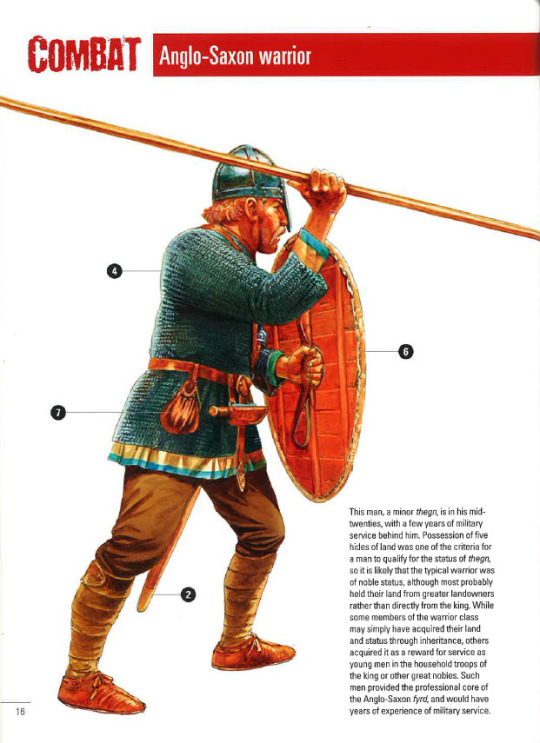
(The average Anglo-Saxon fighting man)
Much the same situation appears in mid-8th century Lombardy, where king Aistulf demanded that those who had 7 or more properties worked by unfree tenants should perform service with a horse and full equipment, while those with less than this, but who own more than 25 acres (40 iugera) of their own, were required to perform an unarmoured cavalry service. 25 acres is about half the land later Anglo-Norman evidence suggests is the minimum for unarmoured cavalry service, so possibly this was an attempt on Aistulf’s part to enfranchise the lesser freemen and get them to support his usurpation of the crown at the political assembly13. Note, however, that the minimum level for cavalry service is nearly double what a peasant family would need to subsist off and implies a man of moderate wealth in and of itself14.
England is somewhat different, as we lack any specific requirements for those being summoned to military service, but from at least 806 we can surmise that 1 man from every 5 hides of land was required for the army. By this point a “hide” wasn’t a measure of area but of value, approximately £1, in a time when 1d. was the wage of a skilled labourer15.
The implications of this aren’t immediately obvious, but when you consider that Wessex had a population of perhaps 450 000 people, across an area of 27 000 taxable hides, only 5400 men (1 man from every 20 families) were actually required for military service16. Many of these, perhaps even most, would have belonged in the retinues of major landholders as either part of their household or as landed warriors owing service to the landholder in exchange for their land. In the same vein, the one man from every hide who was required to maintain bridges and fortifications, as well as defend the burhs (not serve in the field!), was drawn on the basis of something like 1 man for every 4 families. These are heavy responsibilities, but still far from men with sickles and pitchforks making up the fyrd.
There are some exceptions, or else cases where the evidence is thin enough that it’s difficult to say one way or the other, and these typically occur in areas that a less densely populated and less wealthy. The kingdom of Dal Riada in the seventh century, for instance, raised about 3 men from every 2 households for naval duties, although it might also have called out fewer warriors from the general population of the most powerful clan for land warfare17.

(A replica of the Gokstad ship)
Scandinavia is somewhat trickier, since a lot of the sources are late and from a period where central authority existed. We know from archaeological evidence that, in Norway, large scale inland recruitment of men for naval expeditions had been occurring since the Migration Era, as the number of boathouses exceeds the best estimates of local populations18. These were initially clustered around important political and economic centers, but spread out more evenly across Norway during the middle ages as a central political authority arose. This system is likely at least one part of the origin for the leidang system of levying ships, which seems to have properly formed in Norway and Denmark during the late 10th or early 11th century as a result of royal power becoming strong enough to call out local levies across the whole kingdom19.
It seems likely, based on later law codes and other contemporary societies, that Scandinavian raiders during the 8th and 9th centuries were mostly the hird of a wealthy landowner (or their son), supplemented with sons of better off farmers from nearby holdings. Ships were comparatively small at this point, just 26-40 oars (approximately 30-44 men)20, and most had 24-32 oars per ship. This corresponds fairly well with what a prominent landholder might be able to raise from his own household, with additional crews coming from the sons of nearby farmers, although whether this was voluntary, coerced or some combination of the two is impossible to say21.
However, these farmers’ sons, while unlikely to wear mail in the majority of cases, should not be thought of as poor. The vast majority of farmers in 8th-10th century Scandinavia would have had one or two slaves and sufficient land to not only keep their slaves fed and employed, but also to potentially raise more children than later generations22. These farmers’ sons might have been “poor” by the standards of the men they faced in richer areas of the world, but they were rather well off by the standards of their society.
Later, after the end of the 10th century, the leidang was largely controlled by the king of the Scandinavian country and, particularly in the populous and relatively wealthy Denmark, poorer farmers were increasingly sidelined from any obligation to provide military service. Ships also rose in size from the end of the 9th/start of the 10th century, regularly reaching 60 oars for vessels belonging to kings or powerful lords, and even the “average” size seems to have gone from 24-32 oars to 40-50 oars23.
Slaughter Reeds and Flesh Bark: Arms and Armour of the Warrior
The equipment of the warrior consisted of, at its most basic level, a spear and a shield. For those who belonged to a poorer region, a single handed wood axe might serve as a sidearm, or perhaps even just a dagger, while in wealthier regions the sidearm would generally be a sword or a specialised fighting axe24. In an interesting twist, both the poorest and the wealthiest members of society were almost equally likely to use a bow, although I expect that the poorer men mostly used hunting bows, while the professional fighting men used heavier warbows25.
Spearheads, at least from the 7th-11th centuries, were relatively long (blades of >25cm) and heavy (>200g), but most were well tapered for penetrating armour. Some, especially the longest examples, weighed around a pound, but were probably still considered one handed weapons26. Others, however, weighed in excess of two pounds and must have been two handed weapons, possibly the “hewing spear” mentioned in some 13th century sagas27. Javelins, too, appear to have tended to feature long, narrow blades that would have made them a short range weapon, while also providing considerable penetration within their ~40 meter range.
Swords, for their part, were not quite the heavy hacking implement once attributed to them, but also aren’t quite as well balanced as later medieval swords would be. Early swords, before the 9th century, tended to be balanced about halfway down the blade, which might make for a more powerful cut, but didn’t do much for rapid recovery or shifting the blade between covers. However, from the mid-9th century, the balance shifted back towards the hilt, which made them much faster and more maneuverable28. This may indicate a shift towards a looser form of combat, where sword play was more common, or it might indicate nothing more than a stylistic choice. After all, the Celts of the 2nd-1st century BC preferred long, heavy, poorly balanced swords for fighting in spite of relying on the usual Mediterranean “open” style of combat29.

(The Ballinderry Bow)
Warbows, with a couple of exceptions, appear to have been short but powerful. Starting with the Illerup Adal bows, which most likely only had a draw length of 26-27″, we see a repeated pattern when very powerful bows are also much shorter than we expect them to be. In particular, the heavier of the two bows from Illerup Adal is very similar to the Wassenaar Bow, a 9th-10th century bow. A replica of the latter drew 106lbs @ 26″, making it quite a powerful bow, and similar bows have been found at Nydam, Leeuwarden-Heechterp and Aaslum. Only the Ballinderry and Hedeby bows break this trend, with both capable of being drawn to 28″-30″. In all cases, draw weights varied between 80lbs and 150lbs, although 80-100lbs is by far the most common30. The consequence of this is that the power of the bows is not going to be as high as later medieval bows, which were able to be drawn to 30″ and, as the arrows were also relatively light, suggests an energy of 40-60j under most circumstances. This is enough to penetrate mail at close range if using a bodkin arrowhead, but at longer ranges mail would have offered quite excellent protection.
When it comes to shields, there was evidently quite a bit of variation. Early Anglo-Saxon and Merovingian shields were quite small and light, about 40-50cm in diameter31, but later shields were generally 80-90cm in diameter. In particular, we have good evidence of viking shields generally fitting this description, although it’s less clear whether or not later Carolingian and Anglo-Saxon shields retained this diameter or reduced to 50-70cm in diameter (see f.n. 7). In all cases, however, the shield was fairly thin at the center, less than 10mm, and could be as low as 4mm thick at the edge. While thin leather or rawhide could be applied to the front and back of the shield to reinforce it, it’s equally possible that only linen was used to reinforce the shield, or even that the shields were without any reinforcement32.
Recent tests by Rolf F. Warming have shown that this style of shield is rapidly damaged by heavy attacks if used in a passive manner (as in a static shield wall) and that the shield is best used to aggressively defend yourself33. While the test was not entirely accurate to combat in a shield wall (more on this in the second part), it does highlight the relative fragility of early medieval shields compared to other, more heavily constructed shields like the Roman scutum in the Republican and early Empire or the Greek aspis. As I’ve said before, this means we have to rethink how early medieval warfare worked.
Finally, we come to the topic of armour. The dominant form of armour was the mail hauberk - usually resembling a T-shirt in form - and other forms of metal armour were far less common. Guy Halsall has suggested that poorer Merovingian and Carolingian warriors might have used lamellar armour34, and there is some evidence from cemeteries and artwork that Merovingian and Lombard warriors wore lamellar armour in the 6th and 7th centuries, but there’s little evidence to support lamellar beyond this. While it does crop up in Scandinavia twice during the 10th/11th centuries, it was almost certainly an uncommon armour that was used either by Khazar mercenaries or by prominent men who were using it as a status symbol35. Scale armour is right out, Timothy Dawson’s arguments aside, as there is no good evidence of it.
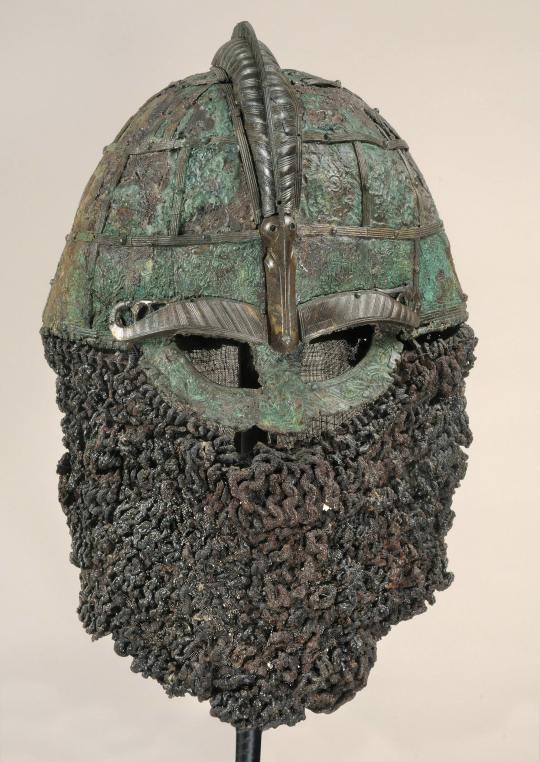
(Helmet from Valsgarde 8)
Helmets evolved throughout the Early Middle Ages, ultimately deriving from late Roman helmets that featured cheek flaps and aventails. During the 6th and 7th centuries, especially in Anglo-Saxon England and Scandinavia, masks were attached to the helmets, either for the whole face or just the eyes. The masks did not long survive the 7th century in Anglo-Saxon England, but the Gjermundbu helmet may suggest it lasted in Scandinavia through to the 10th century. Merovingian helmets of the 6th-8th century tend to be more conical and keep the cheek flaps, but do not have any mask36. Carolingian helmets of the 9th century appear to have been a unique style, more rounded but also coming down further towards the cheeks, and it’s hard to say if this eventually developed in the conical helmet of the late 10th/early 11th century or if it was just a dead end37. Regardless, by the 11th century the conical helmet was the most common form of helmet in England as well as the Continent.
And now for the controversial stuff: non-metallic armour. In short, I don’t think that textile armour was very common during the Early Middle Ages, nor do I think that hardened leather was very common either. The evidence from the High Middle Ages suggests that, unless someone who couldn’t afford to own mail was legally required to own textile armour, they generally didn’t, and we have plenty of quite reliable depictions of infantry serving without any form of body armour38. The shields in use were as much armour as most unarmoured men needed - since, as you’ll recall from the previous section, they rarely fought - and they covered a lot of the body. So far as I’m concerned, there wasn’t a need for it, and plenty of societies through history have fought in close combat without more armour than their shield.
Summing Up
This has been a very basic overview of the background to warfare in the Early Middle Ages, and I know I haven’t covered everything. Hopefully, however, I’ve provided enough background for people to follow along when I dig down into the actual experience of battle in my next post. I’ll cover the basics of scouting, choosing a site to give battle, the religious side of things and then, at long last, the grim face of battle for those standing in the shieldwall.
If you’d like to read more about society and warfare in the Early Middle Ages, then I’d recommend Guy Halsall’s Warfare and Society in the Barbarian Westand Philip Line's The Vikings and their Enemies: Warfare in Northern Europe, 750-1100, which together cover most of Western and Northern Europe from 400 AD to 1100 AD. While I have some disagreements with both authors, their works have shaped my thoughts over the years since I first acquired them. For the Vikings specifically, Kim Hjardar and Vegard Vike's Vikings at War is excellent, as much for the coverage of campaigns across the world as for the information on weapons and warfare.
Until next time!
- Hergrim
Notes
1 For the rarity of the sax in the viking world, see Vikings at War, by Kim Hjardar and Vegard Vike. For the Anglo-Saxon sax, see the list of finds here. Just 5 out of 33 (15%) had blades 44cm or more and, if you remove those longer than the Pompeii style of gladius (which is the point where some think the Romans changed to purely thrusting style), just two fit the bill.
2 Michael J. Taylor’s “Visual Evidence for Roman Infantry Tactics” is by far the best recent examination of Roman fighting styles, but Polybius has been translated in English for ages. See, however, M.C. Bishop, The Gladius, for an argument that the Romans changed to close order and preferred to rely on thrusting by the end of the 1st century AD.
3 See J. C. Coulston and M.C. Bishop, Roman Military Equipment: From the Punic Wars to the Fall of Rome, for the infantry adoption of the gladius. Any general history of the Roman military will cover the transition from open order to close order during the 3rd century AD.
4 Those of you with a copy of Victor Davis Hanson's The Western Way of War need to perform a quick exorcism. You must burn the book at midnight during the full moon and then divide the ashes into four separate containers, one of gold, one of silver, one of bronze and one of iron. You should then bury ashes from the iron container at a crossroads, scatter the ashes in the bronze container to the wind in four directions, pour the ashes from the silver container into a fast flowing river, and finally feed the ashes from the gold container to a cat, a bat and a rat.
5 A.D. Fraser “The Myth of the Phalanx-Scrimmage” is one of the earliest attacks on the idea of literal othismos. The debate reignited in the 1980s, with Peter Krentz’s “The Nature of Hoplite Battle” leading the charge of the heretics, and the conceptual othismos model is now the accepted version. Hans van Wees’ Greek Warfare: Myths and Realities is probably the best revisionist work to start with. Matthew A. Sears, as attractive as he looks, should be avoided.
6 Early Anglo-Saxon Shields by Tania Dickinson and Heinrich Harke
7 Duncan B. Campbell’s Spartan Warrior 735–331 BC has the most easily accessible information on the best preserved aspis, which is ~10mm thick at the center and 12-18mm thick at the edge, but there’s also a good cross section in Nicholas Sekunda’s Greek Hoplite 480-323 BC. For Viking shields, see this page of archaeological examples by Peter Beatson. Note the similarity to oval shields from Dura Europos in thickness and tapering (Roman Shields by Hilary and John Travis). It’s also worth considering that Carolingian and Anglo-Saxon manuscript miniatures tend to show shields that rarely cover more than should to groin, implying a typical diameter of 50-70cm.
8 See Niels Lund’s “The armies of Swein Forkbeard and Cnut: "leding or lið?”” and Ben Raffield’s “Bands of brothers: a re‐appraisal of the Viking Great Army and its implications for the Scandinavian colonization of England” for an examination of how the lið was constructed, and see Richard Abels’ ‘Alfred the Great, the Micel Hæðn Here and the Viking Threat’, in T. Reuter (ed.), Alfred the Great. Papers from the Eleventh-Centenary Conference for a discussion on the nature of viking “armies”
9 10-15 acres depending on crop rotation and how close to subsistence level you want to peg this category
10 The Scandinavian Gulathing and Frostathing laws were only composed in the late 11th/early 12th century, but it has been argued that they were essentially a codification of earlier oral laws. At least with regards to equipment and service, I see no reason to doubt this.
11 Almost all of the relevant capitularies are translated in Hans Delbruck’s History of the Art of War: The Middle Ages, with the original Latin in an appendix.
12 Walter Goffart has made this incredibly clear in his recent series of loosely related articles: “Frankish Military Duty and the Fate of Roman Taxation,” Early Medieval Europe, 16/2 (2008), 166-90, “ The Recruitment of Freemen into the Carolingian Army, or, How Far May One Argue from Silence?” In J. France, K. DeVries, & C. Rogers (Eds.), Journal of Medieval Military History: Volume XVI (pp. 17-34) and ““Defensio patriae” as a Carolingian Military Obligation”. Although I think Goffart argues too strongly against the dominance and importance of aristocratic retinues in the Carolingian military - the great landowners had the most obligation, after all - he does do a brilliant job of highlighting both the universal requirement of service from eligible freemen and the fact that even a “poor” freeman being assessed for service was, in fact, far better off than most of society. This provides some extra context for the prevalence of swords in Merovingian burials, as note by Guy Halsall: it’s not that swords were cheap, it’s that the average Merovingian warrior was rich by the standards of his society.
13 For the text of the capitulary, see Delbruck. For Aistulf’s possible political motives, see Guy Halsall’s Warfare and Society in the Barbarian West. For Anglo-Norman minimum standards for unarmoured cavalry, see Mark Hagger’s Norman Rule in Normandy, 911–1144.
14 I think it’s worth addressing here the pessimistic low crop yields of older authors and their subsequent conclusion that 25-30 acres would be bare subsistence in the Early Middle Ages. As Jonathan Jarrett has proven (”Outgrowing the Dark Ages: agrarian productivity in Carolingian Europe re-evaluated” Agricultural History Review, Volume 67, Number 1, June 2019, pp. 1-28), these low yields are not supported by the evidence, and we should expect yields to be similar to High Medieval yields. His blog contains an early version of his thoughts on the matter.
15 For a recent exploration of the debate around the Anglo-Saxon military, see Ryan Lavelle’s Alfred’s Wars
16 See Richard Abel’s Alfred the Great for this although n.b. his reliance on old crop yield estimates
17 John Bannerman, Studies in the History of Dalriada. The suggestion that the Cenél nGabráin, being the most powerful clan, might have raised fewer men from the general populace for land combat is my own. They may simply have had the largest number of men in military households and, as such, not needed to rely as much on the general populace when on land. It may also be that calling up larger numbers of the free population for land service from the less powerful clans was in and of itself a method of dominance and control - the largest number of armed men left behind for defence/to suppress revolt would be those from the dominant clan.
18 “Boathouses and naval organization” by Bjørn Myhre in Military Aspects of Scandinavian Society in a European Perspective, AD 1-1300
19 That said, the political control of the Scandinavian kings over military levies should not be overstated - it could be very patchy, even in the 13th century. c.f. Philip Line, The Vikings and their Enemies
20 As suggested by Ole Crumlin-Pedersen in Archaeology and the Sea in Scandinavia and Britain, with the estimate of ~40 oars for the Sutton Hoo ship thrown in as a maximum size. Crew estimates are based on 11th century ships in Anglo-Saxon employ where, based on rates of pay and money raised to pay for the ships, there were only 3-4 men more than the rowers on each ship.
21 c.f. Egil’s Saga and the description of Arinbjorn’s preparation for raiding.
22 The Medieval Demographic System of the Nordic Countries by Ole Jørgen Benedictow. The speculation of larger family sizes is my own, based on other medieval evidence that wealthier families tend to have more children.
23 Ian Heath reproduces the leidang obligations of High Medieval Norway in Armies of the Dark Ages, although he incorrectly applies the two men per oar guideline that only became into being during the 13th and 14th centuries. Archaeological evidence only shows ships of 60+ oars or 26 oars, but from the lengthening of the largest ships and the 40-50 oar ships of the later leidang I feel it is appropriate to assume that the number of oars stayed the same from the 10th to the 14th century, it’s just that the number of rowers doubled as ships became heavier. This is similar to the evolution of the medieval galley.
24 I’ve covered saxes earlier in the notes. For axes, see Hjardar and Vike Vikings at War. Axeheads from western Scandinavia were often over a pound in weight, which is double the weight of specialized Slavic war axes and in the same weight range as the heads of broad axes. Even into the 13th century, these wood axes apparently kept turning up at weapons musters as sidearms.
25 Bows were considered an important aristocratic weapon in Merovingian, Carolingian and Scandinavian societies and, while not a prominent aristocratic weapon, it at least wasn’t shameful for a young English nobleman to use one in battle. The division between “hunting” and “war” bows can be seen in the Nydam Bog finds, where the most powerful bows tend to be relatively short (26-28″ draw length) and the longer bows (28-30″ draw length) tend to be fairly weak. Richard Wadge has demonstrated that civilian bows in medieval England were less powerful than military bows during the 13th century, and I’m applying this to the Nydam bows.
26 Ancient Weapons in Britain, by Logan Thompson
27 See “An Early Medieval Winged/Lugged Spearhead from the Dugo Selo Vicinity in the Light of New Knowledge about this Type of Pole-Mounted Weapon” by Željko Demo, and “An Early-Mediaeval winged spearhead from Fruška Gora” by Aleksandar Sajdl
28 Ancient Weapons in Britain, by Logan Thompson
29 The Celtic Sword, by Radomir Pleiner
30 Most dimensions are from Jürgen Junkmanns’ Pfeil und Bogen: Von der Altsteinzeit bis zum Mittelalter, although the information on the Illerup Adal comes to me from Stuart Gorman. Draw weights are only estimates based on replicas of some bows and a formula found in Adam Karpowicz’s “Ottoman bows – an assessment of draw weight, performance and tactical use” Antiquity, 81(313). Draw weights for yew bows in the real world can vary by as much as 40%, so these estimates are only general guidelines.
31 See f.n. 6 for early Anglo-Saxon shields and Halsall, Warfare and Society, for the early Merovingian shields
32 The shields from Dura Europos, constructed in the same way as Scandinavian shields of the 8th-10th century, feature either very thin leather (described as “parchment”), linen or else some kind of fiber set in a glue matrix. In contrast, two twelfth century kite shields from Pola. d, although constructed only with a single layer of planks like a Viking shield, had no covering at all. See Simon James, The arms and armour from Dura-Europos, Syria : weaponry recovered from the Roman garrison town and the Sassanid siegeworks during the excavations, 1922-37 and “Two Twelfth-Century Kite Shields from Szczecin, Poland” by Keith Dowen, Lech Marek, Sławomir Słowiński, Anna Uciechowska-Gawron & Elżbieta Myśkow, Arms & Armour, 16:2
33 Round Shields and Body Techniques: Experimental Archaeology with a Viking Age Round Shield Reconstruction
34 Halsall, Warfare and Society
35 Thomas Vlasaty has a great article that summarises this subject.
36 No real source for this beyond googling pictures of the various Anglo-Saxon, Scandinavian and Merovingian helmets.
37 This Facebook post has some wonderful pictures of the original helmet, a reconstruction of the helmet and comparisons with Carolingian art.
38 eg. the Porta Romana frieze, the porch lunette at the basilica of San Zeno in Verona, the Bury Bible.
34 notes
·
View notes
Text
English History (Part 5): Iron Age
Iron Age (c. 800 – 43 AD)
From the beginning of the Iron Age, relations between the land and people were governed by an advanced concept of territoriality. This concept of territoriality had gained strength over the millennia – leaders & tribes were already firmly associated with specific regions, which can be seen in the boundaries and locations of settlements.
But this all intensified greatly during the Iron Age, and iron played a huge part in it. Gradually, new trade networks and forms of alliance were established. Ritual and ceremonial objects were made out of iron. The iron trade contributed to the eventual shape of England, as the various regions were becoming more intensely organized and controlled.
The hierarchical structure of societies also intensified. There were chieftains and sub-chieftains; warriors and priests; farmers and craftsmen; workers and slaves. Slave irons have been found near St. Albans (Hertfordshire), and a gang chain on Anglesey (an island off the north-west coast of Wales).
Meanwhile, funerary practices for the elite were becoming extremely elaborate. Iron Age chieftains were buried surrounded by molten silver, gold cloth, ivory, iron chainmail suits, and precious cups & bowls. One mortuary chamber was found to have trampled earth around its base, which suggests that people danced there.
Elite women's graves contained many ornaments, including mirrors, brooches and bangles, bowls, beads and tweezers. On woman was buried with a large bronze bowl placed over her face.
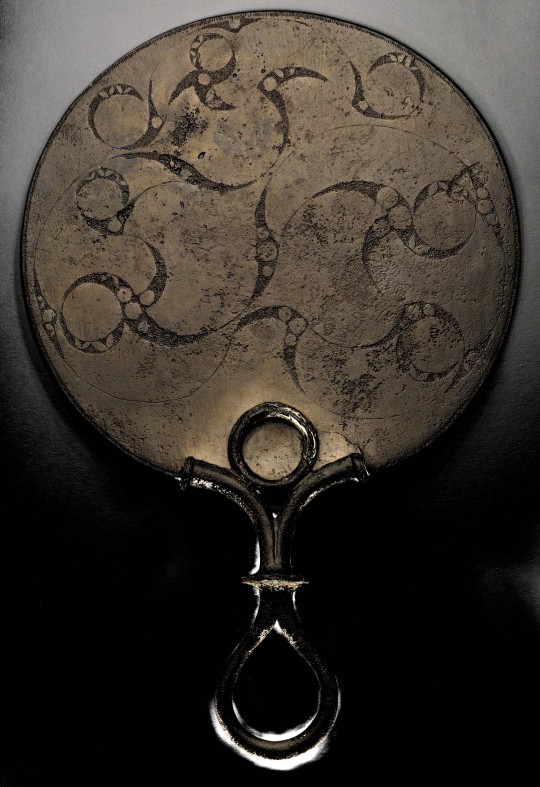
The Oxfordshire Mirror, from the 00s BC.
Because of the increased sense of territoriality, regional identities were strong. This can be seen in the types of settlements in various regions of England:
Eastern England – undefended settlements (similar to villages) among open fields.
South-western England – small communities in defended homesteads, and unenclosed settlements at a distance. This was likely a division between the tribal leaders and the ordinary people.
North-eastern England – defended homesteads.
North-western England – round houses known as “beehive huts”.
Wessex Culture (Salisbury Plain) – a pattern of large territorial groupings based around hill forts.
There are variations upon these themes, such as the pit dwellings carved out of the chalk in Hampshire (a county on the southern coast); and the lake villages of Somerset (south-western England), with round huts built upon floating islands of logs.
The hill forts of Wessex show that this society was strongly hierarchical. They probably originated in the Cotswolds (south-central & south-western England), and then spread over the whole of south-central England. They were a symbol of elite ownership, as they demonstrated the mastery of land and resources.
The territory controlled by each fort was often marked out by linear earthworks that served as boundaries. The forts became more heavily-defended over the Iron Age, and some of them were occupied for centuries.
These hill forts served as towns, not just forts. They had clusters of building and streets, temples and storage facilities, and “zones” for separate industrial activities. The circular houses were made of upright posts, woven together with wattle and sticks of hazel. Their doors & porches faced east. The roofss were usually thatched with reeds or straw, which was held in place with a daub of dung, clay & straw. Soot from the peat fires was a valuable manure, so the dung mixture (and thatch?) was probably replaced each year. The people had small cupboards inside their houses to store weapons in.
The populations of these hill forts were small, from 20 to 200, but they were the beginning of urban English life. It is possible that London was once a hill fort, with its origins buried beneath the modern town.

British Camp, an Iron Age hill fort in Hertfordshire.
The many small tribes of this period lived in a state of constant alert against their rivals. There were cattle raids, conflicts between warriors, and even large-scale wars. Some hill forts were stormed and burned; bodies have been found in the ramparts, with their bones marked & hacked.
In this sort of a culture, heroic songs & tales would have been sung & told to celebrate the deeds of individual warriors and/or leaders. Early Irish epics have such tales, perhaps containing stories & refrains from the prehistoric Irish tribes. A comparison with the Iliad can be made.
These tribes & regional groupings did have network alliances and kinship ties, however. Many smaller clans were eventually integrated, and became larger territorial units (perhaps because of danger). These were the English tribes whom the Romans would confront later.
By the end of the Iron Age, some hill forts had become dominant, and took on the role of regional capitals. The population increased steadily, and so agriculture became even more intensive. People continued to clear woodland and forest. The thick clay soils were worked with heavy wheeled ploughs. This was the foundation for the agricultural economy of England. They grew wheat in Somerset and barley in Wiltshire, and they still do today.
In 325 BC, the Greek merchant & explorer Pytheas landed on England's shores. He named the island as Prettanike or Brettaniai, hence why we have the name “Britain” today. He gave the land of the Picts the diminutive name Pryden. He visited Cornwall, and watched people there work and purify the ore.
Pytheas wrote about the people worshipping various Greek gods, but he was simply projecting the Greek names onto the native Celtic gods. The Greeks saw all foreign gods in their own terms.
He wrote of seeing “a wonderful sacred precinct of Apollo and a celebrated temple festooned with many offerings”. This temple was “spherical in shape”. Close by there was a city “sacred to this god” who kings were called “Boreades” [the Greek god of the cold north wind].
Iron Age art (often called Celtic art) was very intricate, with a mastery of artificial form and linearity. It uses spirals and swastikas, curves and circles. Its patterns are related to the whorls, spirals & concentric circles carved upon Mesolithic passage graves several millennia earlier. This suggests a continuity of belief and worship.

The Battersea Shield (c. 350 - 50 BC), a decorative shield facing.
The religion of England was Druidism. There were certain sacred places, including caves and sacred groves. Druids congregated in these sacred groves, with ancient trees creating the setting for ritual practice.
In a barrow in Yorkshire, dating back to the early Bronze Age, drum-shaped idols made of chalk have been found. They have what seem to be human eyes & noses. 2,000 years later, the British writer Gildas (c. 500 – 570 AD) wrote of these “diabolical idols...of which we still see some mouldering away within or without the deserted temples, with the customary stiff and deformed features.” This shows that there was a long tradition of worship that may have had its roots in the Neolithic Period.
The image of the horned god Cernunnons has been found at Cirencester (Gloucestershire), and images of the horse goddess Epona in Wiltshire and Essex. In East Stoke (Nottinghamshire), a carving of the hammer god Sucellus has been found. The mysterious god Lud (or Nud) has his name in Ludgate Hill & Ludgate Circus (London).
There were religious sanctuaries all over the land, and even the smallest settlements probably had their own central shrines. They have been found in hill forts, within ditched enclosures, along boundaries, and above barrow graves. Often, Roman temples or early Christian churches were built atop them.
During the Iron Age, it was believed that the rooster served as a defence against thunderstorms. This is why we have weathercocks on church steeples.
Human sacrifice was practised, probably in order to sanctify the land. One man was bludgeoned to death and had his throat cut before being deposited in the marsh in Cheshire (north-western England). In southern England, many skeletons have been found in the bottom of bits, flexed into unnatural positions.
Severed heads, probably believed to be the site of the soul/spirit, were also important. Skulls have been found lined up in a row. Often the bodies of defeated enemies were beheaded, and their heads either buried or placed in running water. 300 skulls have been found in the Thames, dating from the Neolithic Period to the Iron Age.
According to Caesar, the Druids (high priests) created images of wicker-work, which they “fill with living men and, setting them on fire, the men are destroyed by the flames.” The Druid priests were the lawmakers of the land – they determined rewards & punishments; and settled disputes over boundaries & property.
Pliny wrote that the Druids “esteem nothing more sacred than the mistletoe”. The high priests “select groves of oak, and use the leaves of the mistletoe in all sacred rites.” They tied the sacrificial victim to an oak tree, and the killers wore chaplets (garlands/circlets worn on the head) made of oak leaves.
The Druids practised divination, astrology and magic. They believed that the soul was immortal, and was reincarnated. The Roman writers considered this belief to make clear the native English contempt for death.
The Druids worshipped the sun and moon, and this solar belief persisted even after their demise. In 1452, a butcher from Standon (Hertfordshire) was accused of proclaiming that there was no god except for the sun and moon. The Druids' power was retained by the Anglo-Saxon bishops, and the tonsures of early Christian monks may also have originated with the Druids. Thomas Hardy, in Tess of the d'Ubervilles, notes that “old customs” last longer on clay soils.
By 100 BC, there were 15 large tribes in England, and they were coming under the control of leaders who were now being called kings. In the years before the main Roman invasion, Suetonius named Cunobelis (leader of the Catuvellauni) as “rex Britannorum”. Cunobelis' capital was St. Albans (Hertfordshire, southern England), and he controlled a large area north of the Thames, including Cambridgeshire, Bedfordshire and Oxfordshire. The Catuvellauni were a fully-formed elite culture of warriors and priests, and its traditions went back to the early Bronze Age. Cunobelis is the Cymbeline of Shakespeare's play of the same name.

Territory of the Catuvellauni.
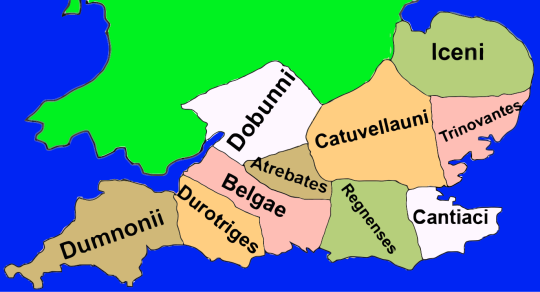
Territories of southern Britain’s Celtic tribes.
At some time during the 400s BC, members of the Parisii (a tribe from northern Gaul) settled in Yorkshire, where they created an archaeologically distinctive community. During the 00s BC, a tribe called the Belgae launched a small invasion, and eventually settled in Hampshire, Essex and Kent. The Roman name for Winchester was Venta Belgarum, meaning “the market of the Belgae”.
England's population during the late Iron Age was about 2 million, and by the time the Romans left, it would be 3 million. It was a flourishing, wealthy country, with a surplus of corn, which was why the Romans wanted to invade it.
The south of England was particularly well-off. In south-eastern and central southern England, there was a spread of settlements with extensive towns & villages, markets, industries, shrines, cemeteries and fields. Julius Caesar stated that “the population is very large, their homesteads thick on the ground and very much like those in Gaul, and the cattle numerous. As money they use either bronze or gold coins or iron bars with a fixed standard of weight.” The coins had the stamp of powerful leaders, and made trade easier between tribes.
The further north you went, the less there was of all this. This was because the southern tribes had been trading extensively with Rome and Romanized Gaul long before the Roman invasion. They loved certain foods and luxury goods, and were Romanized to a fair extent.
But they still had their ancient tribal ways as well. There was consistent warfare between tribes, and various leaders appealed to Rome for assistance. Large earthworks were built as boundaries. The warriors rode chariots to battle, and were naked, covering their bodies with blue woad, and having pierced tattoos. Caesar wrote: “They wear their hair long, and shave all their bodies with the exception of their heads and their upper lips.”
#book: the history of england#history#prehistory#classics#trade#economics#art#art history#bronze age#iron age#britain#ancient rome#prehistoric britain#iron age britain#bronze age britain#roman britain#england#wales#wessex culture#catuvellauni#parisii#belgae#hampshire#somerset#yorkshire#druidism#pytheas#julius caesar
33 notes
·
View notes
Text
I'm not an Anglo-Saxon Heathen but I have some familiarity with it.
One of the best runologists in general was R. I. Page, who specialized in English runes, his book An Introduction to English Runes is indispensable. Maureen Halsall's edition/translation of the rune poem, The Old English Rune Poem: A Critical Edition, is the best one available; failing that there's "The Significance of the Rune Names" by Inmaculada Senra Silva. Also recommended is Victoria Symons' Runes and Roman Letters in Anglo-Saxon Manuscripts. If you want to go really hardcore look for Runica Manuscripta: The English Tradition by René Derolez; it's hard to find but pirated copies do exist.
There are a bunch of sites for learning Old English online and I'm not familiar with most of them, nor do I know Old English, but it will probably be of benefit to know about oldenglishaerobics.net. The standard Old English dictionary is online for free: bosworthtoller.com/.
Some authors to know are Alaric Hall and Philip A. Shaw; Shaw's book Pagan Goddesses in the Early Germanic World more or less set the current academic baseline in discussions about Easter/Eostre (i.e. you don't have to agree with him but it's not really feasible to ignore him). A lot of ASH like Richard North but I do not, his methodologies are not rigorous he's been a vector for nonsense like "Gefjun appears in Beowulf."
You might have started to pick up on this already, but Theodism is kind of its own thing, separate from a more general ASH, and you'd be well-advised to steer clear of it, or to read up on it only for self-defense reasons. Theodism has at its core a formal, pyramidal, social-religious hierarchy and has a history of drawing people who want power over others. It's unsurprising that people like Dan Halloran and Daniel L. Morley were drawn to Theodism specifically. Separately, they also just have a lot of really weird ideas about paganism and reconstructionism and unfortunately they have been very influential to heathenry in general, especially in the US and England.
Hello all! I am hyper fixating on Anglo-Saxon Polytheism (AKA: Anglo-Saxon Heathenry, Anglo-Saxon Paganism, Fyrnsidu, Theod, and many other names I guess?)
I tried looking these terms up on tumblr for more community based info but got pretty much nothing except Norse Heathenry.
I know about the websites larhusfyrnshida, fyrnsidu.faith , wind in the world tree, and even this one (which idk if I agree with them as a group or not but they did have some interesting info) wednesburyshire.
A lot of this info is very hard to understand because they use a lot of the old English words and sometimes just inaccessible regular English.
I would really like to know if there are people here on tumblr that practice specifically Anglo-Saxon Heathenry and if there are any good books on the myths, customs, rituals, and even books on how to understand the runes and how to learn Old English.
Any help would be amazing, and I would love to follow your account if you’re an Anglo-Saxon heathen!!!
(Cross posting to Norse Polytheism tags bc there are literally no Anglo Saxon ones 😭)
47 notes
·
View notes
Text
Non-Western Anarchisms Rethinking the Global Context
“The future of anarchism must be appraised within a global context; any attempt to localize it is bound to yield a distorted outcome. The obstacles to anarchism are, in the main, global; only their specifics are determined by local circumstances.”
- Sam Mbah
“To the reactionists of today we are revolutionists, but to the revolutionists of tomorrow our acts will have been those of conservatives”
- Ricardo Flores Magon
Introduction
The purpose of this paper is to help anarchist / anti-authoritarian movements active today to reconceptualize the history and theory of first-wave anarchism on the global level, and to reconsider its relevance to the continuing anarchist project. In order to truly understand the full complexity and interconnectedness of anarchism as a worldwide movement however, a specific focus on the uniqueness and agency of movements amongst the “people without history” is a deeply needed change. This is because the historiography of anarchism has focused almost entirely on these movements as they have pertained to the peoples of the West and the North, while movements amongst the peoples of the East and the South have been widely neglected. As a result, the appearance has been that anarchist movements have arisen primarily within the context of the more privileged countries. Ironically, the truth is that anarchism has primarily been a movement of the most exploited regions and peoples of the world. That most available anarchist literature does not tell this history speaks not to a necessarily malicious disregard of non-Western anarchist movements but rather to the fact that even in the context of radical publishing, centuries of engrained eurocentrism has not really been overcome. This has been changing to an extent however, as there here have been several attempts in just the past decade to re-examine this history in detail in specific non-Western countries and regions, with works such as Arif Dirlik’s Anarchism in the Chinese Revolution, Sam Mbah’s African Anarchism and Frank Fernandez’ Cuban Anarchism. It is within the footsteps of this recent tradition that this paper treads further into the relatively new ground of systematically assessing, comparing and synthesizing the findings of all of these studies combined with original investigation in order to develop a more wholly global understanding of anarchism and its history.
To begin our inquiry we first must make clear what it is that is actually meant by the term “Western anarchism.” Going back to the debates within the First International, it quickly becomes apparent that this term is a misnomer, as it is actually the opposite case that is true; anarchism has always been derived more of the East / South than of the West / North. As Edward Krebs has noted “Marx (and Engels) saw Russianness in Bakunin’s ideas and behavior” while “Bakunin expressed his fears that the social revolution would become characterized by ‘pan-Germanism’ and ‘statism.’” This debate has led some to characterize it as largely between Western and Eastern versions of socialism; one marked by a fundamental commitment to order and the other marked by a fundamental commitment to freedom (1998, p. 19). So in this sense anarchism can be understood as an “Eastern” understanding of socialism, rather than as a fully Western tradition in the usual sense of the term. At the same time it should be remembered that there also developed an extremely contentious North / South split between the more highly developed nations of England and Germany and the less developed semi-peripheral nations of Spain, Italy and others. This split was based on differences of material reality but developed largely along ideological lines, with the northern Anglo-Saxon nations siding primarily with Karl Marx and the southern Latin nations siding with Mikhail Bakunin (Mbah, p. 20). So in both the East / West and the North / South sense, anarchism has often been the theory of choice for the most oppressed peoples; particularly in those societies whose primarily feudal nature writes them out of historical agency in the Marxist understanding of the world. This may explain a good deal of why anarchism became so popular throughout Latin America, and why immigrating anarchists from the Latin nations of Europe were so well received in country after country that they visited, attempting to spread the anarchist vision.
So by employing the label “Western” I am not referring to the actual history of anarchism but rather to the way in which anarchism has been constructed through the multiple lenses of Marxism, capitalism, eurocentrism and colonialism to be understood as such. This distorted, decontextualized and ahistoric anarchism with which we have now become familiar was constructed primarily by academics writing within the context of the core countries of the West: England, Germany, France, Italy, Spain, Canada, United States, Australia and New Zealand. Since there was virtually no real subversion of the eurocentric understanding of anarchism until the 1990s, the vast majority of literature available that purports to deliver an “overview” of anarchism is written in such a way that one is led to believe that anarchism has existed solely within this context, and rarely, if ever, outside of it. Therefore, the anarchism that becomes widely known is that which has come to be identified with the West, despite its origins in the East; Kropotkin, Bakunin, Godwin, Stirner, and Goldman in first wave anarchism: Meltzer, Chomsky, Zerzan, and Bookchin in second and third wave anarchism. Rarely are such seminal first wave figures as Shifu, Atabekian, Magon, Shuzo, or Glasse even mentioned; a similar fate is meted out for such second and third wave figures such as Narayan, Mbah, and Fernandez — all of non-Western origin. This construction of anarchism as Western has unfortunately led to an unintentional eurocentrism that has permeated the writings of many second and third wave theorists and writers. Their work then becomes the standard-bearer of what anarchism actually means to most people, as it is printed and reprinted, sold and resold perennially at anarchist bookfairs, infoshops, bookstores and other places, as it is quoted and analyzed, compared and debated in reading circles, academic papers, at socials, parties, demonstrations, meetings and on picketlines. Clearly, there has been a great deal of reverence in second and third wave anarchist movements for this “Western anarchism” — the result has been that much of anarchism has moved from being a popular tradition amongst the most exploited in societies the world over to being little more than a loose combination of an academic curiosity for elite Western academics and a short-lived rebellious phase of youth that is seen as something that is eventually, and universally, outgrown.
This paper demonstrates an alternative understanding in the hope that this fate can be overcome; that anarchism, in the first quarter of the 20th century, was the largest antisystemic movement in almost all parts of the world, not just in the West. Upon considering that over three quarters of the global population is situated outside of the West, it quickly becomes clear that anarchism actually claimed the greatest number of adherents outside of the West rather than within it as well. Therefore, it is fair to say that not only has anarchism been a globally significant movement from its very inception, it has also been a primarily non-Western movement from its inception as well. This basic fact was reconfirmed with the rise of second wave anarchism, spanning from the late 1960s and on into the early 1970s in India, Argentina, Mexico, and South Africa (Joll, 1971, pg. 171). In turn, third wave anarchism, which has risen to popularity from the late 1990s to the present, also reconfirms this in resurgent movements in Brazil, Argentina, Korea, Nigeria and elsewhere. The relevance of this particular essay, however, is to critically reexamine the first global wave of anarchism in order to enable anarchists to think more holistically and effectively about the relevance of the past and its long-term effect on the present. This attempt to critique the narrow vision of “Western anarchism” should of course result in a more accurate understanding of the significance and potentiality of second and third wave anarchism in both the present and the future as well. Indeed, it was a similar motivation that drove the critique of Leninism / Stalinism that came out in the wake of the largely anarchist inspired events of May 1968, as well as the critique of Maoism that came in the wake of the Democracy Movement of the late 1970’s in China; both of which contributed greatly to the development of second and third wave anarchism worldwide.
In working to critique our understanding of the past though, there are several points that should be kept in mind at all times. A cursory reading into the contextual history surrounding these waves of anarchism could easily seem be to unearthing several “historical stages.” For instance one might get the impression that first wave anarchism universally fell into decline worldwide with the rise of the Bolsheviks, or that the decline of state socialism since 1989 has been the “lynchpin” that brought anarchism back in its third wave. While both statements are indeed true to a certain extent, the temptation to systematize and essentialize global social movements in order to make them easier to digest is one that should be undertaken with great care and discrimination; indeed, often it is a step that should not be undertaken at all. The reason is that one cannot ever fully understand the nuance and complexity of the thousands of social movements that have pulsed through non-Western societies through the lens of any singular overarching theory; even seemingly small factors of social difference can render them worthless. For instance, while anarchism declined in much of the world after the October Revolution of 1917, in large sections of the planet this was precisely the point at which anarchism rose to a level of unprecedented popularity. In these countries this was largely due to the saturation of anarchist-oriented periodicals in a particular local language — which meant of course that anarchism became the major filter for general alternative understandings of the nature of events in the world. In other words a rather minor variation in language and social conditions from one region of the world to the next rendered any broad statement on the global significance of Lenin’s rise to power completely indefensible. Or, for instance, if one was to posit that primitive communism “inevitably” has given way to feudalism, followed lockstep by capitalism, socialism and finally communism, that person would be rendering the entire history of hybrid African socialisms non-existent. These attempts at constructing universal laws in the understanding of history are the sorts of things that need to be deliberately avoided in order to understand the significance of difference in the creation of the whole. Indeed, as Theodore Adorno has shown in Negative Dialectics, it is only through negation and difference that one can conceive of the historical process in its entirety (Held, 1980, p. 205).
So, while the world has been connected on the global level for several centuries now, and there are many patterns that seem to present themselves as a result, it is important to remember that this connection has also been entirely uneven, chaotic and unpredictable. As a result, what is true for one particular region is not true for another, and what is true for a particular country within a particular region is often not true for a sub-region lying within it. Therefore universal declarations about history tend to crumble quite easily when put to the test of criticism. This critique becomes especially simple amongst the representatives of the worst of such deterministic thinking. For instance, as Sam Mbah has pointed out, many Marxist-oriented academics have even gone to such an extent as to argue that colonialism can be understood as being a “good” thing as it has allowed all parts of the world to reach the capitalist “stage” of history, a “necessary” precondition of course, to the dictatorship of the proletariat. In order to avoid this sort of univeralistic absurdity, I have chosen to focus in this paper not just on the positivism of sameness and homogeneity between disparate regions, but equally so on negation, heterogeneity and difference. That is, I attempt to discover that which makes the anarchisms of various non-Western countries, regions and subregions unique, with an eye as well to what aspects they may have in common and how they have been interconnected. It is my hope that in this choice I will have made a greater contribution to the future of the global anarchist project by consciously choosing not to define the histories of non-Western societies for them. Instead I let the individual histories speak for themselves, drawing connections where they actually exist, while allowing contradictions to arise freely as they must. I do this deliberately, as this is the approach of one who would be an ally.
Despite my decision to avoid adopting any one overarching theory, I have decided to focus primarily on one particular time period; from the late 19th Century up until the end of the first quarter of the 20th Century. While second and third wave anarchists typically describe this time period as the being the domain of what they call “classical” anarchism I argue that anarchism has always been a decentered and diverse tradition. Rather than essentializing an entire time period as being of one persuasion or another I choose to focus instead on the primacy of contradiction and difference, using the “wave” concept as a means of understanding the wax and wane in the global spread of anarchisms rather than as a way of defining the nature of the anarchisms themselves. While this would seem to put a temporal framework over the development of a historical ideological current that is not necessarily bound by such frames, my approach in this regard is not related to the pursuit of temporal frameworks but rather to the refutation and deconstruction of the concept of “classical” anarchism as a homogenous body of thought that can be located in a specific time and place. This is because I believe that this notion of classical anarchism plays a key role in the construction of the concept of Western anarchism, as it is in the context of the West that this conception has developed and it is never in reference to non-Western anarchism that such terminology is used. Ironically, by focusing on a particular time period, I actually am attempting to deconstruct the false dichotomy of “classical” vs. “postmodern” currents of anarchism in order to show that such temporal understandings of the “progressive” development of anarchist currents are ultimately flawed. This is because they do not recognize anywhere near the full spectrum of thought that has existed on the global level in the history of anarchist ideas; nor do they recognize the direct connections between early ideas and more recent ideas.
If “Western anarchism” is a eurocentric construction, then of course, “non-Western” must also be somewhat problematic. By employing it, I do not mean to give the impression that non-Western societies can or should be seen as some homogenous singular “world” in any sense. Nor am I implying that within the West itself there are not peoples who are originally or ancestrally of non-Western societies or that these peoples have never engaged in anarchist activity. Indeed, a more complete study of non-Western anarchisms would investigate additionally the history of anarchism amongst indigenous peoples and people of color within the borders of Western countries. However, I do make a particular point to focus on the considerable impact global migrations and the resultant ideological hybridity has had on the development of anarchism – some of this has even been within the borders of the Western countries, notably Paris and San Francisco. Another criticism that I anticipate is my inclusion of Latin America in the context of this study and what exactly the term “the West” is supposed to mean here. To this question I reply that by including Latin America I am denying that the region can be understood as being wholly a part of “the West” simply because much of the region’s populations identify strongly with the colonist culture – or perhaps it could be said that it is the colonist culture that identifies them. Rather, in the tradition of Guillermo Bonfil Batalla, I recognize the “deep” indigenous context that these largely mestizo societies were born within and the lasting impact this has had, and continues to have on these societies. In this way, Latin America can indeed be seen as being part of the context of non-Western societies. For the purposes of this study, which is to attempt to piece together a history of anarchism in those countries in which it has been largely ignored, I would define the term “the West” as essentially being comprised of Europe, Australia, New Zealand, Canada and the United States. These regions and nation-states are grouped together because they have represented the heart of world domination from the late 15th Century to the present, both in opposition to the self-determination of the rest of the world, and in opposition to the self-determination of indigenous peoples, people of color and working class people within their own borders.
All nation-states in the world are today hybrids of both Western and non-Western as the phenomenon of globalization has enforced the hegemony of the neo-liberal capitalist project the world over. This is not just a result of the force of arms: it is also because non-Western countries largely responded to encroaching domination by the Western world by both emulating it and by adopting its basic values and ideas. But what the West never counted on was that by promoting and enforcing “modernization” through the Social Darwinist cocktail of neo-liberalism, colonialism, industrialization and capitalism, they were also indirectly legitimizing the anti-Social Darwinist versions of modernization, that is to say, the socialist and anarchist projects. However, as Turkish anarchists have recently pointed out, non-Western “socialism” often fell in line with the modernization project, even allowing neo-liberal capitalist Structural Adjustment Programs. In contrast, they have pointed out that “anarchism was born of the Western and modern world, yet at the same time it was a denial of these things…anarchism was a denial of modernity and Western domination” (Baku, 2001). So throughout the world, many non-Western peoples saw their governments bowing to the pressures of the West and took the only options that came within that modernist package which seemed to offer either a modicum of liberty or equality, anarchism or socialism. In this way, it can be said that the modernist project was turned inside out and against itself by those it would intend to victimize and place under its control. This inside-out modernism (or anti-modernism) was spread through the global migration of anarchists and anarchist ideas, more often than not a result of forced exile. Erricco Malatesta for instance, helped to spread anarchist communism from countries a far apart as Lebanon and Brazil, and Egypt and Cuba. Kotoku Shusui almost single-handedly delivered anarchist syndicalism to Japan after spending time organizing with the American IWW in San Francisco in 1906. And Kartar Singh Sarabha became a major influence influence on the Indian anarchist Bhagat Singh after organizing Indian workers in San Francisco in 1912.
Throughout this work, which will consider anarchism in its Asian, African, Latin American and Middle Eastern regional contexts, there are three primary areas of investigation that we are interested in. The first of these is a consideration of what specifically local social conditions lead to the rise of anarchism as an ideology and how these conditions shaped its growth into a uniquely hybrid manifestation of the world anarchist movement. The second is to map and to analyze the influence of the migrations and inmigrations of peoples and ideologies and how these differing social contexts influenced each other through a hybrid exchange. The last area of investigation, which is contained in the conclusion, is to assess which unique aspects of first wave non-Western anarchisms carried over into second wave anarchism, as well as to consider what valuable aspects of first and second wave anarchism have to the continuing anarchist project, now in its third wave.
Asian Anarchism: China, Korea, Japan & India
In order to begin to challenge the predominant Eurocentric understanding of anarchism and its history, one should begin first with the most populated continent on the planet, Asia. With over half of the global population, to ignore the volatile political history of the region is to engage in the worst sort of eurocentrism; this is of course, not to mention the shallow and warped understanding of anarchism that one then arrives at as a result. Throughout many parts of Asia, anarchism was the primary radical left movement in the first quarter of the 20th Century. This should be considered quite significant to the anarchist project because within the global context China is by far the most populated country with a population of over 1.2 billion people. India comes in second in population at just over 1 billion. The two countries hold over 1/5 of the world’s population respectively, and in each, anarchist thought has risen to a level of political importance unparalleled in the other smaller nation-states within Asia. In terms of population share alone, these facts make a rethinking of the global context extremely valuable, and this is why I begin here. Within the continent, we will begin first with China then move on to the other countries of East Asia, and then I will proceed to India.
There were multiple locally specific reasons why anarchism gained such widespread popularity in China. Many have pointed out the “limited government” (wuwei) element in traditional Chinese thought, ranging the gamut from Taoism to Buddhism to Confucianism. In line with this view, Peter Zarrow claims in Anarchism and Chinese Political Culture that anarchism was “created out of the ruins of Neo-Confucian discourse.” Building on this belief, he goes on to trace the connections between Taoist ideas of “order without coercion” and the later emergence of anarchism (1990, p. 5). While there certainly is some truth to Zarrow’s claims, what must be deliberately avoided is any overfocus on the “anarchistic” elements contained within Chinese traditional thought to the detriment of an understanding of the important role played by global migration and by colonialism itself. As Arif Dirlik has remarked, an overfocus on traditional thought can also be said to be somewhat Orientalist, as it attributes “everything new in China to Chinese tradition…another way of saying that there is never anything significantly new in China.” Alternatively, Dirlik posits that “the Chinese past is being read in new ways with the help of anarchism, and conversely there is a rereading of anarchism through Taoist and Buddhist ideas” (1997). In other words the development and spread of ideas is never a completely one-way process, it is always an exchange.
In any case, this is just one part; another major reason was that practically no Marxist theoretical works had been translated into Chinese until around 1921, and even then a movement based around it failed to materialize until around the end of the decade. As a result, anarchism enjoyed a nearly universal hegemony over the movement from 1905–1930, thereby serving as a sort of filter for developments in the worldwide radical movements. Even Russia’s October Revolution of 1918 was claimed as an “anarchist revolution” as a result, though this distortion did not last. So unlike in the rest of the world, the anarchist movement in China did not fall with rise of the Bolshevik victory in Russia, but instead rose in popularity along with it (Dirlik, 1991, p. 2).
In China, anarchism arrived at the apex of its popularity during the “Chinese Enlightenment,” also known as the New Culture Movement. It was through the conduit of influential Western ideas of liberalism, scientism and progress that anarchism was able to gain a foothold. And ironically, it was from the new realization of China as a nation-state in a decentered, cosmopolitan world of nation-states, rather than as the center of all culture, that brought about the rise of an ideology that called for the abolition of the nation-state (p. 3).
The concept of “cultural revolution,” which is the very definition of variance between Chinese socialism and that of the rest of the socialist movement, can be traced directly back to this heavily anarchistic “New Culture” period when Mao himself was a member of the anarchist People’s Voice Society and enthusiastically endorsed the thinking of the important anarchist leader Shifu amongst others (Dirlik, p. 195; Krebs, p. 158).
Of course, the anarchist conception of cultural revolution varied greatly from the Cultural Revolution which Mao actually put into practice, as by then he had been thoroughly convinced of the need for centralized, absolute authority after extensive contact with the Comintern. It is from the anarchist movement of this period that most of the later leaders of the Chinese Communist Party would later emerge.
When speaking of “Chinese anarchism” one might be tempted to think of it as simply that which developed within the actual borders of the country. But to do so would be to disregard the important influence migration has had on the movement, which was quite internationalist in scope. On the mainland, Chinese anarchist activity was concentrated primarily in the Guangzhou region of southern China, as well as in Beijing. In Guangzhou, Shifu was the most active and influential of the anarchists, helping to organize some of the first unions in the country. Students from Guangzhou formed the Truth Society, the first anarchist organization in the city of Beijing amongst many other projects. But like other nation-states around the world at this time, China was quickly becoming a more dynamic, diverse nation marked deeply by the repeated invasions of foreign powers as well as by the global migrations of it’s own peoples. Anarchists lived and organized in Chinese communities the world over, including Japan, France, the Philippines, Singapore, Canada and the United States; of these, the two most significant locations were the diaspora communities in Tokyo and Paris.
Of the two, the Paris anarchists were ultimately the more influential on a global level. Heavily influenced by their European surroundings (as well as whatever other personal reasons brought them there), they came to see much of China as backwards, rejecting most aspects of traditional culture. Turning towards modernism as the answer to China’s problems, they embraced what they saw as the universal power of science, embodied largely in the ideas of Kropotkin. In this spirit, Li Shizeng and Wu Zhihui formed an organization with a strong internationalist bent, called “the World Society” in 1906 (Dirlik p. 15). In contrast the Chinese anarchists in Tokyo were such as Liu Shipei were blatantly anti-modernist, embracing traditional Chinese thought and customs. Living in a different social context, for many different reasons, they were far more heavily influenced by anarchism as it had developed in Japan; which brings us of course, to the question of Japanese anarchism.
As in China, the October Revolution in Japan did not carry the same downward impact on the movement as it had in so many other parts of the world. In fact, the period immediately following 1917 became the apex of Japanese anarchism in terms of actual numbers and influence (Crump, p. xvi). Anarchism in Japan was quite diverse, but from amongst the broad array of anarchisms were two major tendencies; the class struggle ideals of anarchist syndicalism, promoted by figures such as Kotoku Shusui and Osugi Sakae, and the somewhat broader tendency of “”pure anarchism” promoted by activists like Hatta Shuzo. Both tendencies attracted a sizeable number of adherents, and both had their heyday at different points in the first quarter of the twentieth century.
The anarchist-syndicalists followed in the footsteps of the Bakuninist tradition of collectivism, which was largely based on exchange relations: to each an amount equal to their contribution to the greater collective. In addition, the syndicalists were largely concerned with the day-to-day struggles of the working class, reasoning that the larger goal of revolution had to be put off until they had reached a significant degree of organization. After the revolution, the revolutionary subjects would retain their identities as “workers” as they had been before the revolution. The most prevalent embodiment of this tendency was the All-Japan Libertarian Federation of Labour Unions (Zenkoku Jiren), an important anarchist-syndicalist federation of labor unions founded in 1926 that boasted over 16,000 members (Crump, p. 97).
In 1903 Kotoku Shusui resigned from his job as a journalist in Tokyo when it announced its support for the Russo-Japanese war and the occupation of Korea. He went on from there to start the anti-war Common People’s Newspaper (Heimin Shinbun) for which he would soon be imprisoned. While in jail, he made contact with anarchists in San Francisco, and became more and more intrigued by anarchist theory. After getting out of jail, Shusui moved to San Francisco, organized with members of the IWW, and returned to Japan with the intellectual and practical seeds of syndicalism. This development would soon influence figures such as Osugi Sakae and lead to the formation of Zenkoku Jiren (Crump, p. 22).
In contrast, the pure anarchists were more similar to anarchist communists in the tradition of Kropotkin, combined with a strong anti-modernist, pro-traditionalist bent. As a group they were embodied largely in the militant organization the Black Youth League (Kokuren). Historically, the mid-19th Century “agricultural communist anarchist” theorist Ando Shoeki is considered by many to have been their primary philosophical predecessor. The pure anarchist critique of anarchist syndicalism was focused largely on the syndicalist preservation of a division of labor in the administration of the post-revolutionary society. This division of labor meant that specialization would still be a major feature of society that would lead to a view that focused inwardly on particular industries rather than blending the intellectual and the worker. The pure anarchists also sought to abolish exchange relations in favor of the maxim from each according to their ability, to each according to their need. In a sense, they can be seen as attempting to develop a more uniquely Japanese interpretation of anarchism. For instance, they questioned the relevance of syndicalism to a society that was still largely peasant-based and had a relatively small industrial working class (Crump, p. 7).
Despite the variance between syndicalist and pure anarchisms, in general the one thing they had in common was that all Japanese interpretations of anarchism were hybrid theories, made relevant for the local situation. That situation was an extremely repressive one; meetings were broken up, demonstrations suppressed and anarchist publications banned on a regular basis throughout the life of first wave anarchism. The Red Flags incident of 1908 is a good example of this, when dozens of anarchists celebrating the release of political prisoner Koken Yamaguchi were brutally attacked and arrested simply for displaying the red flag. Translation and publication of anarchist texts were often done secretly in order to avoid repression, as was Kotoku’s translation of Kropotkin’s The Conquest of Bread. Another aspect of unique local conditions was that texts that described Western realities had to be made relevant to the local population. For instance, in the widely available Japanese translation of Kropotkin’s Collected Works, the European “commune” was transformed into a traditional Japanese farming village (Crump, p. xiii). But this process also occurred partially through the conduit of Western anarchists, and through the migration and inmigration of people and ideas. This is of course, is the way in which these essays became translated into Japanese. Kropotkin corresponded directly with Kotoku several times and agreed to allow him to translate several of his major works, while his travels to San Francisco resulted in dramatic changes in Japan’s anarchist movement as well. So this global connection of anarchists was extremely important, but as I have demonstrated, it was made relevant to people on the local level.
Another local condition that shaped the development of East Asian anarchism was that Japan had its own “Monroe Doctrine” of sorts over most of region. As has often been the case elsewhere, Japanese anarchists used their relative degree of privilege as a means to spread anarchism throughout the region. These efforts throughout Asia led to the formation of the Eastern Anarchist Federation, which included anarchists from China, Vietnam, Taiwan and Japan. This is in fact, how anarchism first reached Korea after Japan’s 1894 invasion in order to “protect” it from China. Korean migrants living in Tokyo came under the influence of Japanese anarchism and engaged heartily in the anti-imperialist movement. As a result, over 6,000 were rounded up after incredulously being blamed by the authoritarian Japanese state for Tokyo’s 1923 earthquake. They were beaten, jailed, and two were even sentenced to death along with their Japanese comrades in the “High Treason Case” (MacSimion, 1991). Later, during the 1919 independence struggle, in which anarchists were prominent, refugees migrated into China, which was at the height of anarchist influence as a result of the New Culture movement. At the same time, Japanese anarchists at the time continued their solidarity work with the Korean liberation movement.
By 1924, the Korean Anarchist Communist Federation (KACF) in China had formed with an explicitly anti-imperialist focus and helped to organize explicitly anarchist labor unions as well. At the same time, anarchist tendencies were developing within Korea itself. For instance the Revolutionists League is recorded to have organized around this time and to have maintained extensive communications with the Black Youth League in Tokyo. By 1929, their activity had materialized fully in Korea itself, primarily around the urban centers of Seoul, Pyonyang and Taegu. The apex of Korean anarchism however came later that same year outside the actual borders of the country, in Manchuria. Over two million Korean immigrants lived within Manchuria at the time when the KACF declared the Shinmin province autonomous and under the administration of the Korean People’s Association. The decentralized, federative structure the association adopted consisted of village councils, district councils and area councils, all of which operated in a cooperative manner to deal with agriculture, education, finance and other vital issues. KACF sections in China, Korea, Japan and elsewhere devoted all their energies towards the success of the Shinmin Rebellion, most of them actually relocating there. Dealing simultaneously with Stalinist Russia’s attempts to overthrow the Shinmin autonomous region and Japan’s imperialist attempts to claim the region for itself, Korean anarchists by 1931 had been crushed (MacSimion, 1991).
Throughout East Asia, anarchists demonstrated a strong commitment to internationalism, supporting each other and reinforcing each other’s movements rather than thinking simply in terms of their own nation-states. The “nationalism” of Chinese and Korean anarchists can thus be seen as a form of anarchist internationalism dressed up in nationalist clothing for political convenience. In both of these countries, the anarchist movement sought to reinforce nationalist struggles insofar as they cast off imperial domination; but they were decidedly internationalist in that the long term goal was to abolish both the Chinese and Korean nation-state systems as well. The same can be said for Japanese anarchists who lent their solidarity to the anti-imperialist movements in Japan, Korea and other parts of East Asia. As noted earlier, the rise of the Eastern Anarchist Federation and its paper “The East” (Dong Bang) is testament to the global nature and focus of anarchism during the early 20th century.
Though India is located on the Western border of China, connection and communication between the anarchisms of both are relatively unknown since in India anarchism never really took on much of a formally named “anarchist” nature. In India, the relevance of anarchism is primarily in the deep influence major aspects of it had on important movements for national and social liberation. In order to understand the development of the heavily anarchistic Satyagraha movement in India, one must first consider the objective local conditions in which it developed. India is the second most populated country in the world, weighing in at over 1 billion people. Going back into ancient Hindu thought, one can indeed find predecessors to the concept of a stateless society; the Satya Yuga for instance, is essentially a description of a possible anarchist society in which people govern themselves based on the universal natural law of dharma (Doctor, 1964, p. 16). But at the same time that a stateless society is seen as a possibility, much of Hindu political thought is focused on the inherently evil nature of man and the therefore “divine right” of kings to govern, so long as they maintain protection from harm for the people. If they do not govern on the basis of dharma, however, the Chanakyasutras allow that “it is better to not to have a king then have one who is wanting in discipline” (p. 26). This of course is a major contrast with the Western notion of a universal divine right of kings regardless of the consequences.
Anarchism finds its first and most well-known expression in India with Mahatma Gandhi’s statement “the state evil is not the cause but the effect of social evil, just as the sea-waves are the effect not the cause of the storm. The only way of curing the disease is by removing the cause itself” (p. 36). In other words, Gandhi saw violence as the root of all social problems, and the state as a clear manifestation of this violence since its authority depends on a monopoly of its legitimate use. Therefore he held that “that state is perfect and non-violent where the people are governed the least. The nearest approach to purest anarchy would be a democracy based on nonviolence” (p. 37). For Gandhi, the process of attaining such a state of total non-violence (ahimsa) involved a changing of the hearts and minds of people rather than changing the state which governed them. Self-rule (swaraj) is the underlying principle that runs throughout his theory of satyagraha. This did not mean, as many have interpreted it, just the attainment of political independence for the Indian nation-state, but actually, just the opposite. Instead, swaraj starts first from the individual, then moves outward to the village level, outward further to the national level; the basic principal is that of the moral autonomy of the individual above all other considerations (p. 38).
So overall, Gandhi’s passion for collective liberation sprang first and foremost from a very anarchistic notion of individualism; in his view, the conscience of the individual is truly the only legitimate form of government. As he put it, “swaraj will be an absurdity if individuals have to surrender their judgement to a majority.” While this flies in the face of Western notions of governance, Gandhi reasoned that a single sound opinion is far more useful than that of 99.9% of the population if the majority opinion is unsound. It was also this swaraj individualism that caused him to reject both parliamentary politics and their instrument of legitimization, political parties; he felt that those who truly wanted a better world for everyone shouldn’t need to join a particular party in order to do so. This is the difference between Raj-Niti (politics of the state) and Lok-Niti (politics of the people). Swaraj individualism meant that everything had to be rethought anew: for instance, the notion that the individual exists for the good of the larger organization had to be discarded in favor of the notion that the larger organization exists for the good of the individual, and one must always be free to leave and to dissent (p. 44).
However, Gandhi’s notions of a pacifist path to swaraj were not without opposition, even within the ranks of those influenced by anarchism. Before 1920 a parallel, more explicitly anarchist movement was represented by India’s anarchist-syndicalists and the seminal independence leader, Bhagat Singh. Singh was influenced by an array of Western anarchisms and communisms and became a vocal atheist in a country where such attitudes were extremely unpopular. Interestingly, he studied Bakunin intensely but though he was markedly less interested in Marx, he was very interested in the writings of Lenin and Trotsky who “had succeeded in bringing about a revolution in their country.” So overall, Singh can be remembered as something of an Anarchist-Leninist, if such a term merits use. In the history of Indian politics, Singh is today remembered as fitting somewhere between Gandhian pacifism and terrorism, as he actively engaged in the organization of popular anti-colonial organizations with which to fight for the freedom of India from British rule. However, he was also part of a milieu which Gandhi referred to as “the cult of the bomb” — which of course he declared was based upon Western notions of using violence as a means to attain liberation. In response, Indian revolutionaries countered that Gandhi’s nonviolence ideas were also of Western origin, originating from Leo Tolstoy and therefore not authentically Indian either (Rao, 2002). It is in fact likely that Singh was influenced by Western notions of social change: like his Japanese counterpart Kotoku Shusui, Singh’s comrade and mentor Kartar Singh Sarabha organized South Asian workers in San Francisco, leading both of them to eventually commit their lives to the liberation of Indians the world over.
Notable amongst this milieu was the Hindustan Republican Association as well as the youth organization Naujawan Bharat Sabha; both of which Singh was involved in. Despite his earlier reluctance, by the mid-1920s Singh began to embrace the strategy of arming the general Indian population in order to drive the British out of the country. In service to this mission he traveled throughout the country organizing people’s militias, gaining a large following in the process. In 1928 this strategy of organized armed revolt gave way to an open support for individual acts of martyrdom and terrorism in an article Singh published in the pro-independence paper Kirti. In other issues of this same paper he published his famous essay on “Why I am an Atheist” as well as several articles on anarchism. In the anarchist articles, Singh equated the traditional Indian idea of “universal brotherhood” to the anarchist principle of “no rulers,” focusing largely on the primary importance of attaining independence from any outside authority whatever. Though he had been influenced by the writings of Lenin and Trotsky, Singh never did join the Communist Party of India even though he lived for six years after its original founding. (Rao, 2002). Perhaps this was due to the anarchist influence in his ideas; either way anarchist ideas (if not anarchist ideology as a whole) played a major role in both Gandhian and Singhian movements for swaraj.
African Anarchisms: Igbo, Egypt, Lybia, Nigeria and South Africa
Early African anarchism developed along the extreme continental margins, primarily in the context of ethnically diverse North African and South African port cities. Other than the small amount of literature available on these movements, very little has been published on the subject. As in the Indian context, this is partially because there is less of a history of anarchism here as a coherent ideologically based movement. But it is also partially due to the hegemony of either capitalist-imperialist nation-state systems or post-colonial “African socialist” sytems throughout the region. The largest anarchist movement on the continent in the first quarter of the 20th century was that of South Africa. Indeed, recent studies conducted by Nigerian anarchists such as Sam Mbah have noted that anarchist thought as an ideology did not in any substantial way reach much of the African continent until the mid-20th century (1997, p. 1). However, while acknowledging the lack of an ideologically coherent form of anarchism, throughout their study anarchistic social elements found amongst many African tribes are greatly emphasized. In this way tribal “communalism” is understood as a non-Western form of anarchism, uniquely and specifically within an African context. In their own words “all…traditional African societies manifested ‘anarchistic elements’…the ideals underlying anarchism may not be so new in the African context. What is new is the concept of anarchism as a social movement or ideology” (p. 26).
In this usage, the term communalism is used somewhat similarly to Marx’s conception of “primitive communism” – a stateless society that is post-hunter gatherer and pre-feudal — though such grand narratives are not taken seriously. This is because this “historical stage” is one that most of Africa never “advanced” beyond, especially in the rural areas of the continent. In this context, elders in the tribal community are recognized as leaders on the basis of experience, but not as authorities with access to any form of a legitimate use of coercion, per se. Religion and “age-graded” groups of males who performed specific tasks for the village acted as methods of maintaining an internal social cohesion, though some stateless societies were also matrifocal (p. 33). In particular the Igbo, Niger Delta Peoples, and Tallensi are well known for being marked by anti-authoritarian, directly democratic social formations. They organized primarily around the supreme authority of mass village assemblies in a form of direct democracy, tempered with the advice of the council of elders. Though these societies were primarily patriarchal, women played certain roles in the governance of society through their own organizations as well (p. 38).
The advent of so-called “African socialism” emerged out of the colonization, industrialization and urbanization of the continent. This began with the Berlin Conference of 1884–1885 in which Europe carved Africa up into nation-states, placed over and between the stateless societies that had formed the basis of decentralized continental social administration in the past. These colonial nation-states facilitated the extraction of natural resources to the benefit of European elites, destroying, displacing, dividing and undermining stateless societies. In many African nation-states, the anti-colonial movement was led by “African socialists” such as Muammar Gadhafi of Libya, Gamel Abdel Nasser of Egypt and “negritude socialists” such as Senghor. The one thing most of these had in common was that they were very quickly co-opted and subjugated to the interests of Western capital. But while such African socialisms were largely controlled by a Marxist orientation, shaped and guided by outland capitalist interests, not all were.
After Nigeria gained independence in 1960, it implemented a nationwide collective farming system based on a synthesis of elements of traditional African communalism and the Israeli Kibbutzim system. Likewise it can be seen that Gadhafi’s well-known “Green Book” was as influenced by his reading of Bakunin as it was by his reading of Marx. His concept of jamarrhiriyah was also quite similar to that of the Nigerian collective farming system. But far more exemplary than either of these is the theory and practice of Julius Nyerre’s Ujamaa system. In this system, where capitalism is opposed as much as “doctrinaire socialism,” a renewed form of African communalism became the basis of postcolonial Tanzanian society. Unfortunately the Ujaama system ultimately failed as a result of a rapid degeneration into state control over the peasantry under the watchful tutelage of the World Bank (p. 77). On the African continent, Tanzania was by no means alone in this development, which curiously occurred as often in the “socialist” nation-states as it did in the capitalist nation-states.
As mentioned earlier, one country that did have a significantly large organized anarchist movement in the early 20th Century was South Africa. A white Afrikaner by the name of Henry Glasse had helped to organize the earliest rumblings of an anarchist movement in the country in the late 19th Century. Shortly after the turn of the century, the Social Democratic Federation was founded in Cape Town by a coalition of anarchists and other anti-state socialists, followed by the emergence of the short lived South African IWW. The one thing that stood out about these formations at the time was that they were overwhelmingly made up of whites, in a nation-state in which the vast majority was not. Most of the higher paying skilled labor jobs went to whites, while Indians, coloureds (mixed-race people), and poor whites took the “in-between” jobs and blacks were stuck with the most labor intensive unskilled labor jobs (van der Walt, 2002).
This situation finally changed in 1917 when members of the International Socialist League helped to organize the mostly black syndicalist organization, the Industrial Workers of Africa. While heavily influenced by the IWW, it retained the early pro-political DeLeonist elements that had been abandoned in the IWW after the split between syndicalists and DeLeonists in 1908 (Mbah, p. 66). When some began to question the efficacy of engaging in electoral politics the Industrial Socialist League was born with an explicitly direct-action, anti-electoral orientation. From 1918 to 1920, the African National Congress had several anarchist syndicalists amongst its leadership. But by 1921 first wave anarchism was on its last feet in South Africa, as leading activists abandoned anarchism in the service of building the Communist Party of South Africa. As has been shown already, anarchists in many countries became important communist leaders in China, and as we will soon see, such was also the case in Brazil and other Latin American countries as well.
As in South Africa, North African port cities on the Mediterranean played a major role in the spread of anarchist ideas as well. The Egyptian anarchist movement is a good example of this trend, for here anarchism was almost entirely an immigrant phenomenon. As early as 1877, the Egyptian anarchist movement began to put out the Italian language anarchist journal II Lavoratore, which was followed shortly by La Questione Sociale. Its primary audience was Egypt’s thriving Italian immigrant community concentrated primarily in the Mediterranean port city of Alexandria. As Alexandria was a port city, it was quite diverse and would act as a reservoir not only for anarchist activity but for anarchist exiles from around the Mediterranean region as well. In the late 19th Century Malatesta sought refuge here after the attempted assassination of King Umberto I, as did Luigi Galleani in the year 1900. Soon, the anarchist ideas of the Italian community would spread to Greek immigrant workers, who would then go on to organize an anarchist-oriented labor union for shoemakers in Alexandria. However, there is little evidence that anarchist ideas spread in any significant way out of the immigrant communities and into the indigenous Egyptian communities themselves (Stiobhard).
Tunisia and Algeria were the two other countries where anarchism gained a foothold. The port city of Tunis in northern Tunisia featured an anarchist movement amongst Italian immigrants, and as in Egypt, they engaged in publishing several journals including L’Operaio and La Protesta Umana. The latter was published by the well-known pamphleteer Luigi Fabbri, who was living in Tunis at the time. In addition, the port city of Algiers in northern Algeria was a major repository for anarchist activity featuring several anarchist newspapers including L’Action Revolutionnaire, Le Tocsin, Le Libertaire, and La Marmite Sociale. Though there is little information available about the interim period, it well documented that after the failure of the Spanish Civil War in 1939, many anarchists relocated to Algeria around the port city of Oran (Stiobhard).
Latin American Anarchism: Argentina, Uruguay, Brazil, Chile, Mexico and Cuba
The development of anarchism in Latin America was a process shaped by the unique nature of each country within the region, as well as by those factors which many of them had in common. One thing they all had in common was their subordinate relation to the 1823 Monroe Doctrine which held “the Americas” under the tutelage of the one country that arrogantly refers to itself as the only “America” — that is, the United States. As such, shortly after independence was achieved from Spain and Portugal, the Western Hemisphere was promptly re-colonized — unofficially – in the name of U.S. interests. It was in this subordinate context that the first anarchist movements in Latin America arose, all too often under the iron fist of dictators imposed from above, in El Norte. In addition, it is important to note that the Latin American governmental context was far more influenced by the thinking of Aristotle and St. Thomas Aquinas than it was by liberalism, the largest philosophical influence in the Anglo-Saxon democracies (Erickson, 1977, p. 3). Here, corporatism was the major philosophical force, espousing a view of the state as “organically” reflecting the moral will of the people, rather than as a “referee” for different political forces in society as in North America. The ironic result of this was that all oppositional forces would be seen by much of society as essentially anti-liberatory. The ideological process of corporatism involved a sly combination of officialistic cooptation of revolutionary movements and violent repression of those who would not accept such moves. The prevalent role of the Roman Catholic Church in society combined with the tradition of Roman law made up the other two primary factors that set Latin American societies apart from much of the North. This meant of course, that the anarchisms that developed there were qualitatively different as they arose in a significantly different political environment.
In Latin America, the anarchist movement was without a doubt strongest in South America; and in South America, anarchism was without a doubt strongest in the “southern cone” countries of Argentina, Uruguay and Brazil. It was the largest social movement in Argentina from around 1885 until around 1917 when state-socialists took control of the large union federations (Joll, 1971, p. 218). The movement was extremely contentious due to the prevalence of the latifundia system in which a very few families controlled almost all of the land. This extreme social stratification set the stage for Peronism, a system in which the old elite families ruled with impunity over the masses of newly arrived immigrants in an extreme aristocratic fashion. Since the only legal means of affecting change in this society was voting, the fact that up to 70% of the urban population was legally disenfranchised did not endear many to the system; in fact, it created a social situation ripe for the development of anarchism.
Anarchism was most popular amongst Argentina’s working class sectors: it really never attained a high degree of organization amongst the peasantry. However, there were some attempts to organize anarchist student unions in addition to anarchist labor unions (Joll, p. 222). Stirnerist individualist anarchism never found much audience here and so as in many countries around the world, the movement was a balance between anarchist-communists in the tradition of Kropotkin and anarchist-collectivists in the tradition of Bakunin; however there was very little conflict between the two streams. The Italian anarchist-communist Erricco Malatesta immigrated in 1885 and within two years had organized the country’s first Baker’s Union in 1887. This move helped to set the stage for the organizing of the Resistance Societies, an affinity-group form of worker organization that was the backbone of the FOA, which in 1904 became the FORA.
From 1905 — 1910 the anarchist movement exploded in popularity, generalizing into the popular movements and pulling off general strikes in Buenos Aires and other places. Society became so unstable that martial law was routinely imposed for short periods of time. Workers were shot at Mayday demonstrations, others imprisoned at Tierra Del Fuego, and torture was rampant. Simon Radowitsky, a youth who threw a bomb at the Chief of Police’ car quickly became a well-known martyr when he was sentenced to life in prison. In fact he was so popular that eventually determined comrades organized to a plan to successfully break him out of jail (p. 219).
La Semana Tragica— the Tragic Week — was an important event that occurred in 1919 when a general strike was declared but was brutally put down by Colonel Varela, resulting quickly in his assassination. By 1931, the military had taken over and the anarchist movement was suppressed through a combination of death squads, prison sentences and general intimidation. When martial law was finally lifted nearly two years later, all the anarchist newpapers and organizations that had previously been at odds discarded with the past and published a joint declaration called Eighteen Months of Military Terror. The intense repression in Argentina had resulted in a great deal of solidarity and mutual aid amongst different types of anarchists, leading to a number of joint publications and actions that transcended diverse ideologies. It was from this new solidarity that both the FORA and other anarchist organizations sent delegations to the International Brigades for the Spanish Civil War against Franco. But soon Argentina would have it’s own fascist government to contend with. General Peron officially seized power in 1943, forcing the FORA to go underground again, along with La Protesta Humana. When the Peron regime finally fell, another joint publication involving all anarchist tendencies was issued called Agitacion. Other publications included El Descamisado, La Battallaand La Protesta Humana, the paper with which Max Nettlau and Erricco Malatesta were involved. In the face of such repression, much of the population had accepted the strategic cooptation of popular movements by the Peronist state; those who didn’t accept it often looked to the Bolshevik Revolution in Russia as proof that anarchism was no longer a viable idea. The eventual failure of the Spanish Civil War didn’t help matters either, and eventually anarchism became of marginal influence (p. 230).
As in Argentina, Uruguay’s anarchist movement was largely composed of immigrant European workers who had come from industrialized societies, this meant that anarchism was in the early years primarily a working class rather than a peasant movement. Here too, it was the largest revolutionary movement in the first quarter of the 20th Century. The movement was largely based on affinity group based Resistance Societies affiliated to the FORU, which formed in 1905. Malatesta soon became involved in the FORU as well, influencing it away from Bakuninist collectivist anarchism and towards Kropotkinist communist anarchism. The FORU worked on a wide variety of issues, well outside the scope of the business unions. For instance, a major campaign against alcoholism was initiated, as well as initiatives to set up cooperative schools and libraries. These developments came largely due to the anarchist focus on the importance of creating a parallel anarchist culture. While much of this came out of the FORU, most anarchist culture, including plays, poetry readings and other events of the time, came out of those affiliated with the Center for International Social Studies (CIES) in Montevideo (p. 224). The CIES was heavily involved as well in the anarchist press, with such publications as La Batalla – presumably named after the earlier Argentine paper of the same name — which was published continuously for over fifteen years.
Dynamic in many ways that other anarchist movements were not, the Uruguayan anarchists were very internationalist in scope as well; some would say too much so. When the Mexican revolution erupted onto the global stage in 1910, Uruguay’s anarchist movement sent delegations to help the Magonistas; they likewise aided the CNT-FAI with International Brigade soldiers in the thick of the Spanish Civil War (p. 226). The eventual decline of anarchism in Uruguay stemmed primarily from the successful Bolshevik revolution and the enormous ideological loyalty-based splits that emerged in the movement between the FORU and the USU as a result.
The final anarchist movement of the southern cone countries we will examine that which developed within the massive nation-state of Brazil. Within the context of Brazilian latifundia, corporatism and authoritarianism in which large landholders held great sway over the destiny of the vast majority of the population with the backing of the military and the state, mutual aid societies and cooperatives were the only recognized legal form of organization. But as in Argentina and Uruguay, clandestine affinity-group based Resistance Leagues formed the backbone of militant Brazilian unionism, protecting anarchists from repression. However, this anarchist unionism was limited largely to skilled artisans and other workers, leaving the majority of other types of workers such as immigrants and women without union representation.
As in China and South Africa, the Brazilian communist party, the PCB, grew out of the ruins of the once-volatile anarchist movement (Chilcote, p. 11, 1974). However, anarchism had the greatest influence in Brazil primarily from 1906 to 1920, mostly amongst urban immigrant workers. It was in this context it became the predominant stream within the labor movement by 1906, far more important in fact, than state-socialism (p. 19). Anarchist labor militants, active in the Congresso Operario do Brasil (COB) are remembered for helping the Brazilian working class to win the eight-hour day as well as significant wage increases across the board. The Sao Paolo General Strike of 1917 marked the first of three years of militant anarchist activity within the labor movement. During these years, a strategy of repression combined with cooptation became the strategy of the corporative state. Anarchists did not initially call the General Strike, rather it was initiated by those masses of female textile workers whom anarchist organizers had ignored. At first this self-activity of working women and other sections of the industrial working class put male anarchist leaders on the defensive. But ultimately the anarchists accepted female leadership and chose to work with them rather than against them (Wolfe, 1993, p. 25).
The anarchist movement in Brazil began its decline for several reasons; one was that it often failed to adequately reach out to the rural majority population. Another is that the success of the Bolshevik revolution spelt the beginning of the end anarchist ideological hegemony. As in Argentina and Uruguay, anarchist movement split evenly into two camps: pro-Bolshevik and anti-Bolshevik. Many of the most active anarchists would soon move on to become heavily involved in the activities of the PCB as a result of this split. The party shunned those who did not do so, and internal purges eventually ousted those who retained some anarchist sympathies (p. 33). The final nail in Brazilian anarchism’s coffin was the Revolution of 1930, which marked the beginning of a new era of the officialistic, paternalistic, cooptative system of “corporatism.”
While anarchism in the southern cone countries impacted the global movement to an extent, the anarchist movement that most affected and influenced the direction of anarchism throughout Latin America and much of the rest of the word as well was that which developed in Mexico. This began in 1863, when a Mexico City philosophy professor of Greek descent named Plotino Rhodakanaty formed the first anarchist organization in the country, a coalition of students and professors called the Club Socialista de Estudiantes (CSE). The CSE proceeded to spread their ideas through organizing anarchist labor unions amongst the urban working class; shortly this lead to the first strike in Mexican history, to organizing amongst Indian populations in southern Mexico and eventually to a new organization called La Social, which featured activists from the Paris Commune in exile, eventually reaching a peak level of 62 member organizations nationwide (p. 9). For all of this considerable activity, Rhodakanaty and many of his comrades were eventually executed at the hand of Porfirio Diaz.
As elsewhere in Latin America, the postcolonial period had been marked by dictatorship after dictatorship and then finally a major social revolution in 1910. In this revolution, the cause of the Mexican worker and peasant was taken up by a temporary alliance between Ricardo Flores Magon, Emiliano Zapata, Pancho Villa and Pascal Orozco. Of these, Magon can be characterized most accurately as being an anarchist; his brother Enrique and he published a popular anarchist newspaper called Regeneracion beginning in 1900. Of Zapotec Indian background, the two were driven largely by a determination to ensure the autonomy of Indian peoples in whatever social arrangement would arise out of the revolution (Poole, 1977, p. 5). By 1905, they had formed the anarchist-communist oriented Mexican Liberal Party (PLM); named as such in order to not drive people away, while still remaining thoroughly anarchist in demands. This strategy worked well eventually leading to two armed uprisings that involved members of the IWW as well as anarchists from Italy (p. 22).
Activists with the PLM crossed borders freely to relocate to Los Angeles, San Antonio and St. Louis, several cities in Canada, as well as numerous cities throughout Mexico. In doing so, a loose network of anarchists from all over the world participated in the project of building an anarchist contingent within the Mexican Revolution. Yet this relationship was not always healthy: at one point Magon was even forced to write an angry anti-racist essay in response to a statement by Eugene Debs that Mexicans were “too ignorant to fight for freedom” and that they would surely lose any attempt to rise up (p. 88). The essay pleaded with North American anarchists to take the PLM seriously; “Throughout the world the Latin races are sparing neither time nor money to assist what they recognized immediately as the common cause. We are satisfied that the great Anglo-Saxon and Teutonic branches of the army of labor will not lag behind; we are satisfied ignorance due to language difficulties alone is causing a temporary delay” (p. 90) Then in 1910, Francisco Madero published his “Plan de San Luis Potosi” which called for an uprising starting November 20 of that year; the uprising spread quickly until it became a nationwide revolt led by Magon, Zapata, Villa and Orozco.
Amidst the uprising, one of the few honest elections ever to occur in Mexico took place, which Madero won easily. Before the election occurred, however, Magon, Zapata and their followers had already broken sharply with Madero over the issue of land reform and Indian autonomy and as a result had published their own Plan de Alaya. The Zapatistas and Magonistas took up arms together, bound by a common southern Mexican tribal background that within a few years had lead to the successful encirclement of Mexico City. Huerta’s dictatorship continued as the revolution continued to grow, then, when Huerta resigned and Venustiano Carranza became president in 1917, the Mexican Constitution also came into effect. Due to the influence of Zapata and Magon, many extremely progressive features were included such as the right to an education free of charge, the right of Indians to collectively run farms (ejidos), and other social and land reforms. Unfortunately, Carranza exploited the divisions between anarchist-syndicalists and anarchist-communists and successfully bribed the anarchist-syndicalist Casa del Obero Mundial to organize “Red Battalions” to fight against Zapata and Villa. By 1919, Mexican Col. Jesus Guajardo had ambushed and murdered Zapata, ridding the Carranza regime of their main populist enemy. But once Carranza had been overthrown, Obregon, Calles, as well as a long line of other centrists came to power, opposing the domination of the clergy but supporting foreign investment into Mexico; this development marked the beginnings of the PRI dictatorship and the end of first wave anarchism.
Cuban anarchism developed in the mid-19th Century due to the early intellectual influence of Proudhonian mutualism in the workers movement. By the late 1800s it had reached a higher level of maturity with the rise of the anarchist leader Roig San Martin, the paper he edited El Productor, and the national anarchist organization Alianza Obrera (Fernandez, 2001, p. 20). As with Chinese, Indian and Mexican anarchism however, Cuban anarchism cannot be properly understood solely within the confines of the Cuban nation-state; much important activity occurred in Cuban immigrant communities in Key West, Merida (Mexico) and Tampa as well. In fact, in October 1889 a general strike broke out in Key West with solidarity and support from Cuban workers in Havana, Tampa and Ybor City. Just months before this historic strike, San Martin had died of a diabetic coma, with over 10,000 Cubans coming from all over the island to attend the funeral.
By the turn of the century, the fight for Cuban independence had become a major source of division within the anarchist movement; the working class anarchists accused the independentistas of “taking money from tobacco capitalism” (p. 30). Eventually however, most anarchists rallied around Jose Marti and his Partido Revolucionario Cubano (PRC) which was analogous in its advocacy of democracy and decentralization to Mexico’s PLM. In Europe, anarchists such as Elisee Reclus helped to helped to form international solidarity organizations to support the independence movement. But shortly after independence the United States occupied the island; Errico Malatesta decided to move from New Jersey to Havana to help the anarchist movement there. The Mexican Revolution deeply impacted Cuba’s anarchist movement, and the Magon brothers found their way over to Cuba several times both in the pages of Regeneracion and in person. But the Cuban anarchist movement finally fell into a period of steep decline with the rise of the October Revolution (p. 51). It is remembered however, that it was the anarchists who paved the way in Cuba for both the trade union movement and the socialist revolution that occurred later.
Middle Eastern Anarchism: Armenia, Lebanon, Turkey, Palestine
In light of both historical and recent events, it could easily be argued that the Middle East is and has been of central importance to many developments around the world. As in Africa, this region saw first wave anarchism develop primarily along the margins of the region; Armenian anarchists, for instance, were already being brought under control by the Ottoman Empire by the late 19th Century due to their widespread agitational activity. Of the Armenian anarchists, Alexandre Atabekian maintained the highest international profile and had the most connections to the international anarchist movement, befriending Petr Kropotkin, Elisee Reclus and Jean Grave while studying in Geneva. His friendship with Kropotkin was so great in fact that he was actually with him at his deathbed and subsequently helped to organize the famous funeral procession through the streets of Moscow. Atabekian translated several anarchist works into Armenian and published and distributed an anarchist journal called Commonwealth (Hamaink) that was translated into Persian as well.
Atabekian made a serious attempt to make the politics of anarchism relevant to the political situation of the Middle East. Throughout his writings there is a clear pattern of opposition to both the domination of the Ottoman Empire over Armenia and to European intervention and domination over the region in general. These culminated eventually in the development of the Revolutionary Armenian Federation (Dashnaktsouthian), which was a coalition of anarchists, nationalists, and socialists who amongst other activities, published and distributed several anarchist tracts throughout Armenia. Though their manifesto was early on compared to the rhetoric of the Russian nihilists, Dashnaktsouthian anarchism seems to have been largely replaced by Marxism-Leninism within a few years. However, even as Marxism-Leninism rose to popularity in Armenia, anarchist ideals became popular amongst Armenian immigrants heading to the nation-states of the West, as is evidenced by the publication of several anarchist journals in the Armenian language in the United States around the same time (Stiobhard).
Apart from Armenia, Malatesta is known to have spent time in anarchist communities in the port cities of Beirut, Lebanon as well as Izmir, Turkey (Stiobhard). However, very little is known about the nature of these communities or the extent to which these communities were successful in building an anarchist movement locally amongst the non-immigrant populations. As we have seen in the case of Alexandria and Tunis, Mediterranean port cities were often very diverse and chances are that these anarchist communities were primarily composed of Italian immigrant workers. But there is one more country that anarchism has been present in that has not been discussed: that is Palestine / Israel.
Before the creation of the Israeli state, in the first quarter of the 20th century, an anarchist movement had already begun amongst both Palestinians and Jews which resisted the creation of the Jewish state and worked instead for a stateless, directly democratic, pluralistic society of both Jews and Arabs. Anarchist sections of the “communitarian” movement, inspired by the collaboration of notable Jewish anarchists such as Gustav Landauer and Rudolf Rocker, formed the basis for the early Kibbutzim movement in Palestine, and according to Noam Chomsky, was the original meaning of the term “Zionist.” The original communitarian Zionists opposed the creation of the state because it would “necessitate carving up the territory and marginalizing, on the basis of religion, a significant portion of its poor and oppressed population, rather than uniting them on the basis of socialist principles” (Barsky, 1997, p. 48). Of the anarchist-communitarians at the time, Joseph Trumpeldor was one of the most important, drawing members of the first kvutzot over to the anarchist-communist thought of Petr Kropotkin. By 1923, Kropotkin’s Mutual Aid had become one of the first books ever to be translated into Hebrew and distributed throughout Palestine; this early anarchist groundwork by activists like Trumpeldor became a major influence in the thought of Yitzhak Tabenkin, a leader in the seminal Kibbutz Hameuhad movement. The anarchist-communitarian newspaper, Problemen was the only international anarchist periodical to be published in both Yiddish and Hebrew, and was one of very few voices calling for the peaceful coexistence of Jews and Arabs in the communitarian manner that existed before the creation of the Israeli state. This movement began to die out after 1925, with the creation of the movement for an Israeli state and the solidification of the party (Oved, 2000, p. 45).
Conclusion: Implications for the 21
st
Century High Tide of Anarchism
Through this work it has been demonstrated that one of the most fundamental factors in the development of anarchist ideas and movements has been that of global migration of peoples, which is of course the result of the development of a capitalist and imperialist world-system. Throughout East Asia, it was demonstrated that global anarchist networks between San Francisco, Tokyo and Paris were of prime importance in the development of both anarchist syndicalism as well as “pure anarchism” forms of anarchist communism. In the South Asian context, we know that Gandhi first became involved in his lifelong struggle against British rule while living in South Africa; this was at a time when the anarchist-syndicalist Industrial Workers of Africa were at their prime. The development of African anarchism itself arose originally from imported movements of European immigrant workers in the country, both in South Africa and in the Mediterranean port cities of North Africa. What little anarchist movements there were in the Middle East were largely the result of Italian immigrant workers who had been attracted to anarchist thought primarily within their own community. Throughout Latin America, migrations of peoples were especially important as well with Malatesta’s residence and agitation in Brazil, Uruguay, Argentina, Mexico and Cuba being the prime example.
It has been further demonstrated that in the non-Western context, first wave anarchism arose both as part of the “package” of the modernity project and as a reaction against it, ironically providing subject countries with a “modern” weapon with which to fight modernity and Westernization itself. A similar dialectic is present within second and third wave anarchism, both of which arose largely around the global countercultures of the late 1960s and again in the late 1990s. In the 1960s the United States was busy securing its position as the only superpower on the planet; brutal interventions in Southeast Asia and several other regions demonstrates the importance this goal had for the United States at the time. Yet, not content with simple military operations to secure this power, the promotion of American culture as universal – also understood as the activation of “the spectacle” – became a centrally important part of this strategy. As in the first wave, tucked in along with the society of the spectacle was its antidote; spectacular counterculture. This counterculture had arisen as part and parcel of the broader rise of spectacular culture; but as with the rise of modernity, it also was understood that it was a reaction against it. For example, in Middle Eastern countries like Israel, anarchist organizations such as the “Black Front” arose out the youth counterculture, and published journals like Freaky. These journals, while ostensibly part of the general spectacular culture of Pax Americana, were also some of the only publications in the country to actively oppose and critique wars such as the Yom Kippur War (Do or Die, 1999).
Third wave anarchism is largely regarded as having roots as a cultural phenomenon as well; its gestation period beginning in the decline of the 1980s with the globally networked independent punk counterculture. Unlike second wave anarchism, this counterculture prized independence from corporations at least as much as it did internationalism and worked to build independent networks between punks, bands, zines and local scenes the world over. Small self-produced fanzines became the medium for exchanging ideas and non-corporate record labels, record stores and distribution services. In countries like Brazil, Israel and South Africa the punk counterculture was instrumental in the rebuilding of the anarchist movement. While the encroaching Pax Americana brought a McDonalds to nearly every city on the planet, it also brought – through its distributive arms, cultural magazines and ceaseless promotion of English as a lingua franca – anarchopunk bands like Crass, Conflict and others to the local record store. For many, the 1991 Gulf War provided the first real opportunity to put these ideals into action by organizing mass demonstrations and direct actions all over the world. The very next year this was followed by the actions surrounding the 500th year anniversary of the colonization of the Americas by Europe. And just a few months later came the Los Angeles riots; in the ensuing continental and global reverberations, anarchist punks began to get more involved in direct social activism and organizing. This meant not only a politicization of punk, but also a concomitant ‘punkification’ of radical activism as well as both played off against each other.
The Zapatista rebellion in January 1994 solidified this trend as decentralized, internet-based support networks were formed that spanned the globe, helping to ensure the otherwise unlikely success of a largely non-violent autonomist movement in southern Mexico. By the late 1990s many anarchist punks had diversified their cultural affiliations and began to identify more with activism and anarchism itself than with the independent punk counterculture, which was largely dying. Many engaged themselves with the Zapatista struggle, travelling to Chiapas and working as international observers, or attending the International Encuentros held in Mexico and Spain. The new anti-political tradition of Zapatismo, with its rejection of the universalism of both socialism and anarchism, had a large influence on anarchists the world over. By the time the 1999 WTO uprising in Seattle occurred, many anarchists were already entering the post-Western anarchist paradigm, refusing to label themselves as anarchists per se but still strongly identifying with its basic ideas. Many began to refer to themselves as “autonomist” rather than as specifically “anarchist” per se. The real change brought about by this development was that countercultural resistance had been transcended as a morphing process in the attainment of the “new anarchism” which can be characterized as “post-hegemonic” or as some have called it “post-Western.”
In conclusion then, I would like to briefly assess the results of the synthesis between the social nests which first wave anarchism has formed and the rise of second and third wave anarchism as a counter-spectacle amongst non-Western anarchisms. Despite the common dismissal of almost all anarchism from the early 20th Century as a monolithic “classical anarchism” and therefore worthless and outdated in the context of anarchism’s current third wave, this study of early non-Western anarchism demonstrates that in fact anarchism at the time was no less diverse ideologically than it is today in the early 21st Century. The “pure anarchism” of Japan for instance, in many ways prefigured the current development of a more green anarchism, elements of which are present in anarchist currents within both deep ecology and social ecology. Indeed, John Crump remarked on the remarkable similarities to pure anarchism between Bookchin’s balance of economic self-sufficiency and intercommunal trade (p. 203). Early Japanese anarchism also helped to set the stage for the development in the late 1960’s of Zengakuren, a militant student organization that was praised by the Situationists for its uniting of student and working-class struggles. In its focus on culture, the anarchist movement in China prefigured Mao’s Cultural Revolution but even more so the Democracy Movement of the 1980’s, and it may have helped to inspire the Tiannemen Square incident. Certainly the reassessment of the socialist history of China has been informed by a renewal of interest in anarchism even today in the country. Korea’s early anarchist movement can be seen as a precursor to the Kwangju Rebellion of 1980. As George Katsiaficas has remarked, “like the Paris Commune, the people of Kwangju spontaneously rose up and governed themselves until they were brutally suppressed by indigenous military forces abetted by an outside power” (2001). That military power, was, as one might guess, the United States. The anarchist influence on Gandhi’s Satyagraha movement in India carried through into Vinoba Bhave’s and Narayan’s Sarvodaya movement in the 1960’s and can be seen in more recent movements as well.
In the late 1960’s Argentina experienced a resurgence of its ongoing anarchist tradition through the student movement. The split between the FORU and the USU in Argentina after the Bolshevik revolution meant that not until the 1960’s would anarchism regain somewhat of a constituency. This time around however, it was not based primarily in the working class movements. Rather it was in the student movements as a result of the 1956 formation of the Uruguayan Anarchist Federation (FAU). Some of those originally involved with the FAU, which would eventually move towards more deterministic Marxist tendencies, would go on to form anarchist-oriented student organizations. These activists later helped to build the Center for Popular Action (CAP) as a means to engage wider sectors of the population in anti-authoritarian struggles without the ideological pressures of being explicitly anarchist per se. This tendency shied away from ideological universalism and in favor of a more subjective pluralism or “panarchy” — which would interestingly foreshadow the direction of antiauthoritarian movements at the dawn of the 21st Century all over the world. One of CAP’s pamphlets stated ” in place of hypocritical ‘unity’ we provide an open arena for everyone to do what they feel is necessary…let positions be defined and each work his own way (p. 232).” One other change in the 1960’s was the branching out of anarchists into non-working class sectors such as the peasant movement. All the anarchist groups, indeed all of the left, were involved in building the Movement for the Land (MT) thus uniting both working class and peasant movements in alliance for the first time. Unfortunately, the vision that these new tendencies displayed would ultimately be short-lived due to the imposition of a long series of military dictatorships, meant to serve U.S. corporate interests.
But it is only recently, since December 2001, that these ideas have been seriously tested after the overthrow of the neo-liberal De La Rua regime. First the government destroyed the lives of millions throughout the country by accepting several successive austerity measures handed down from the IMF and World Bank. And on top of state employees not being paid for months in a row, many workers were only allowed to withdraw a limited amount of money from their bank accounts. But then came the final straw: the government took away the full freedom of people to protest by declaring a state of siege. It was at this point that the movement took the radical turn of calling for all politicians to be ousted, and not to be simply replaced by a “more acceptable” set of suits. This is also the point at which people began to take power into their own hands by creating self-governing, horizontally structured neighborhood assemblies, as well as city-wide, regional and national networks of these neighborhood assemblies. Whenever various ideological factions would attempt to seize control of the assemblies, they would be told that no one wanted to follow their ideology, they just wanted direct control of their country (Federacion Libertaria Argentina).
In the Middle East today, anarchism has grown especially in those countries where relatively small movements had emerged in the early 20th Century, largely amongst immigrants. Italian anarchist communities in Turkish and Lebanese port cities have spread since the 1980’s to the local populations, often through the conduit of punk culture. For instance, since the mid-1990’s a Lebanese group called Alternative Liberty (Al Badil al Thariri) has been sending delegates to international anarchist meetings, as well as composing reports on the local anarchist movement and translating anarchist works into Arabic. From around the same time period, anarchism has become a recognized force in Turkish politics as well with the appearance of anarchist contingents at May Day celebrations, and their appearance amongst international anarchist meetings as well. Anarchist Italian and Greek immigrants helped to spread their ideas around the Meditteranan region into the North African countries of Tunisia and Egypt, mostly in the port cities. Though their activity at that point seems not to have had a major effect on the local populations, by the mid-1960’s it seems that at least some Tunisian national was open to anarchist ideas. In 1966, a Tunisian Situationist by the name of Mustapha Khayati helped to write the seminal text On the Poverty of Student Life while studying in Paris. The Algerian section of the Situationist International was represented by Abdelhafid Khatib at its 1958 conference (Stiobhard).
African anarchism has built on first wave anarchism as well as on the traditional society. In Nigeria, the communalist nature of certain traditional tribal societies formed a social environment that would provide a framework for the transformation of the once-Marxist Awareness League in 1990 into a 1,000-member strong anarcho-syndicalist branch of the International Workers Association based primarily in the southern part of the country. In addition to indigenous communalism, the fall of Marxism also formed an important basis for the rise of the Awareness League. Interestingly, Awareness League members have expressed interest not only in the anarchist-syndicalism of the IWA but also in the newer ecological anarchism as expressed by both Murray Bookchin and Graham Purchase. The Awareness League was preceded by an anarchistic coalition in the 1980s that went by the name of “The Axe” (Mbah, p. 52). In 1997, amidst major social upheaval, over 3,200 workers in Sierra Leone are said to have joined the IWW, according to local delegate Bright Chikezie who had come into contact with British IWW member Kevin Brandstatter. A military coup later the same year resulted in mass exile of these IWW members to the neighboring country of Guinea where Bright immediately set about attempting to organize metal workers into the union. After arrival in Guinea, the General Secretary Treasurer of the IWW traveled to Guinea to meet with him and discuss the situation (Brandstatter, 1997).
The strong South African anarchist movement in the early 20th century lead also to the current proliferation of anarchism in the form of anarchist media organizations, bookstores and other organizations. Bikisha Media Collective is an example of this, as is the South African Workers Solidarity Federation. Much of this came out of white and Indian members of the urban punk scene who wanted to put their ideas into practice. The high point of this renewal was the year 1986, which saw the largest general strike in the history of the country when over 1.5 million workers and students struck, demanding recognition of Mayday as a public holiday (Mbah, p. 64). Throughout Africa in general, capitalism is becoming more and more unworkable; a downward development from which “African socialism” already has largely fallen from as a result. Beyond the crises of capitalism and socialism, the post-colonial nation-state system further threatens to give way under the weight of imminent pressure from below; the stateless societies they were propped on top of in order to facilitate imperialism and capitalism cannot function in the context of such a foreign body. Indeed, Mbah has stated quite clearly that the ethnic violence and riots that are seen throughout the continent spell “the beginning of the collapse of the modern nation-state system.” He goes on to say “the rise of a new angry generation during this chaos is an important factor in determining how and in which direction the present crisis is resolved” (p. 104). Such a situation is ripe for the (re)introduction of the decentralized, democratic, self-determined nature of an anarchist system synthesized with the indigenous African system of autonomous yet interconnected stateless societies.
In the final judgement, the relevance of this work to the future of social movements may not be so complex but alternatively, it might be simply to “keep the maps that show the roads not taken” as Edward Krebs has put it (1998, p. xiii). Academics often have a tendency to see everything they develop as being new and unprecedented; I believe this work has demonstrated that while there are several new currents within anarchism today, many of them were preceded by other roads that were not taken or that were conveniently forgotten in the construction of what has become the phenomenon of Western anarchism. In league with the other more specific attempts at such a project in the recent past, I say “let the deconstruction begin.” While we may not know exactly where this project will ultimately lead us, we do know that it will be a place radically more holistic, global, and aligned with the origins of anarchism as a counterhegemonic force than what has developed in the tradition of Western anarchism in the past several decades.
3 notes
·
View notes
Text
Day 107: Conwy

Today we woke up early again and caught the 9:30 bus out of Betws-y-Coed north to the quintessentially picturesque castle town of Conwy.
On the train into Betws-y-Coed the other day, we had seen some spectacular views of the hills surrounding the River Conwy. On the bus, we got to see even more of the countryside. We passed through a patch of gently rolling, lightly wooded hillsides, dotted with picturesque hamlets and colorful terraced gardens, which I can only describe as The Shire.
Much of it still looked like we were back home in California, but the up-close details--the sheep, the actually old buildings, the pleasant Welsh patter of our bus-mates--made its foreignness a bit more clear.
The old Celtic languages in Scotland and Ireland may be dying out, but Welsh is still very much alive and well, at least in northern Wales. Whenever we overheard a pair of Welsh people talking, it seemed just as likely to be in Welsh as in English. And we figured out a clever trick that some Welsh people seem to do when first meeting someone.
The Welsh word for “hello” is helo, pronounced “hee-low.” To someone who doesn’t know Welsh, it just sounds like saying hello with an accent (which I guess it still is), so they just reply with hello. Someone who speaks Welsh, however, will recognize what they said and reply in kind: helo. And without missing a beat, the conversation can proceed in either English or Welsh as if it was never a question.
Also along the way, our bus crossed over the historic Llanrwst stone bridge--which helpfully had a warning “weak bridge” sign posted next to it. I’m not sure what we were supposed to do with that information, but since the bus driver didn’t seem too much bothered by it, I decided to just not think about it.


Conwy is a charming medieval town still circled by walls that have never been breached or bombed. It instantly reminded me of Dubrovnik, Croatia, which I had visited years earlier. To be honest, the comparison was bubbling in my mind long before we actually set eyes on Conwy, but I was gratified to hear another tourist make the comparison while we were on the castle ramparts. (Perhaps more than gratified--I may have given Jessica a disgustingly gratified grin when we both overheard the comment.)
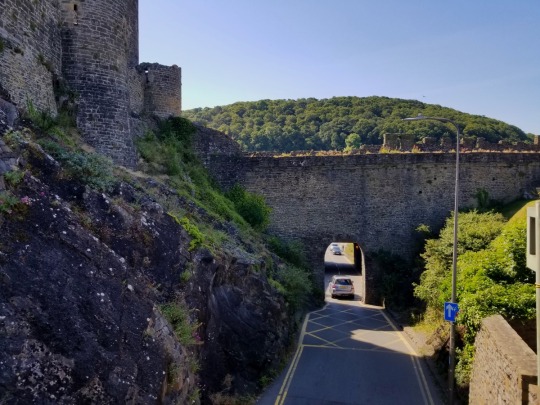
Driving into town, we passed through a narrow archway penetrating the town walls directly under the view of the castle. And after we got off the bus, that was our first stop.
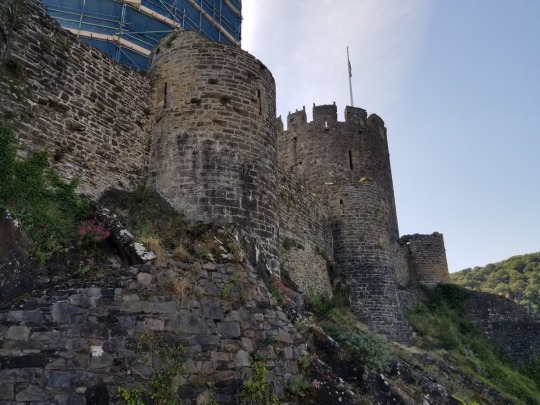


Architecturally, Conwy Castle is beautiful--maybe one of my top favorites. But as a piece of British history, it is hideous.
For much of their history, the relationship between the English and the Welsh could be compared to the relationship between the Anglo-American settlers and the Native Americans. The Welsh had land, and the English wanted it.
(The English name Wales actually comes from an Anglo-Saxon word for “foreigners,” and the Welsh name for England--Lloegyr--may have originally meant “invaders.”)
Unable to stand toe-to-toe with the English army, the Welsh lords did what every native population does when faced with a technologically superior invader. They retreated to the mountains and waged a guerilla war.
The English responded by ringing the wildlands of Snowdonia with a web of heavily fortified castle towns, from which they could contain the Welsh resistance fighters and launch brutal raiding parties whenever they wanted. For over a hundred years, North Wales was where ambitious young knights and nobles would come to prove their mettle and might.
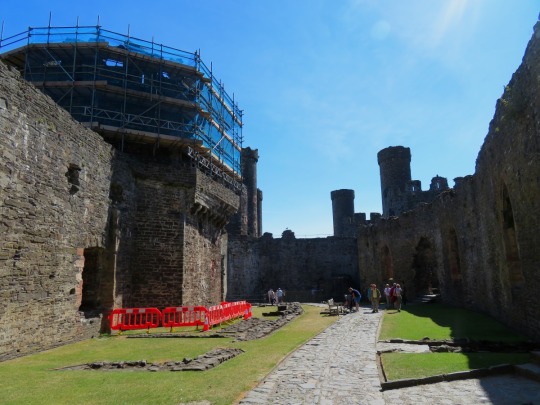

Despite the castle’s grim origins, the Welsh do an impressive job of presenting it in an accessible, even-handed, and even entertaining way. They make a point to focus on the pride and camaraderie of Welsh culture that allowed them to survive and retain their identity as the era of English imperialism slowly rose and fell.
They are particularly fond of one story that involves one of the greatest April Fool’s tricks of all time.

On April 1, 1401, the English garrison left the castle to attend a Good Friday mass in the city below. They were confident in their iron grip of the city, and they left only two guards to hold the castle gate.
While the garrison was out, the castle carpenter--a Welshman--and two apprentices showed up at the gate to do some work. The guards let them in, whereupon the the apprentices--or rather, Welsh freedom fighters disguised as apprentices--slew the guards, let in a small contingent of other freedom fighters, and barred the gate.
Conwy Castle was so well-designed that this handful of Welsh patriots were able to hold it for three months before finally surrendering to the English garrison. Nine freedom fighters were executed for the coup, but the two leaders who had posed as carpenter’s apprentices were pardoned in exchange for their surrender.
Their names were Rhys and Gwilym Tudor. As in the Tudors who would become the kings and queens of England less than a century later. Which went a long way toward easing medieval England’s apartheid rule over Wales.
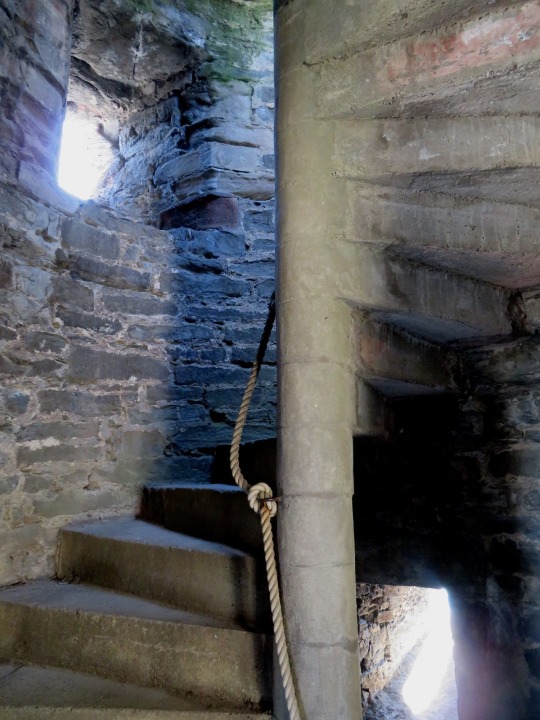
The stairs up to the top of the smaller high turrets around the inner courtyard were ridiculously steep and narrow, but the views were worth it.
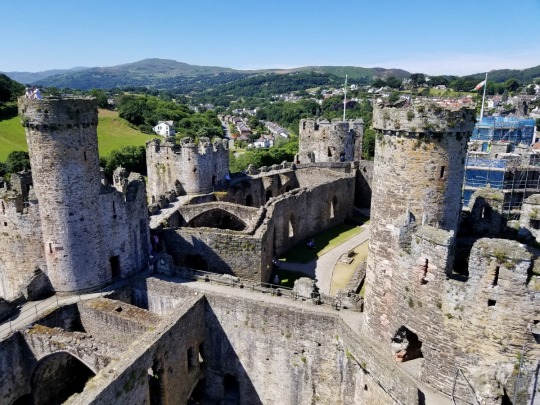

Unfortunately, we then had to climb down the stairs. Very slowly.

In the castle’s great hall, we learned that an invitation here during the Middle Ages could have very different implications depending on the context. The hall served as the venue of choice for both honorary feasting and criminal prosecutions. A hallway leads directly from the hall to a dark pit that condemned prisoners would be thrown into to slowly die of thirst or starvation.
As fascinating as everything in the castle was, Jessica and I were suffering under the sweltering summer heat. It wasn’t just bad by British standards--as a Californian, I can definitively say that it was hot.

Luckily, we found a stairway leading down into a mercifully cool basement at the foot of one tower. As a bonus, we got to see a cool model of how Conwy looked at the peak of the English occupation.
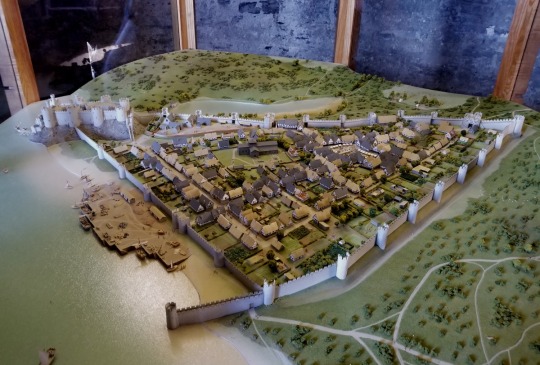
Notice how the only ways in and out of the castle were by boat or by climbing a single steep, narrow stairway.
We also learned the curious connection between Conwy and a London football team.
One of the signs mentioned an English knight named Sir Henry Percy, who also went by the nickname “Hotspur.” Henry was the son of a powerful earl and spent the late 1300s in Conwy enforcing English rule. Henry was later immortalized by Shakespeare for his role as the leader of a failed rebellion against King Henry IV.
Jessica wondered if he was somehow related to the Tottenham Hotspur football club in London, it turns out that he is. The Percy family owned a lot of land throughout the country, including much of Tottenham, then an agricultural hamlet north of London, and the Tottenham football club chose to adopt Henry’s famous nickname. (The nickname came from Henry’s eagerness to charge into battle.)
Leaving the castle, we immediately began searching the streets for a place to eat--as much out of a desire to escape the heat as of actual hunger. We eventually stopped at the Galleon, whose window boasted of having “Possibly the best fish and chips you’ve ever tasted.” We appreciated the slight concession to modesty and decided to test the claim for ourselves.

We’ve had far too many fish and chips now for me to even begin ranking them, but the Galleon’s would probably be pretty high up. The fish was great, but I was particularly intrigued by the chips--they were almost a perfect clone of the fries from In-N-Out Burger.
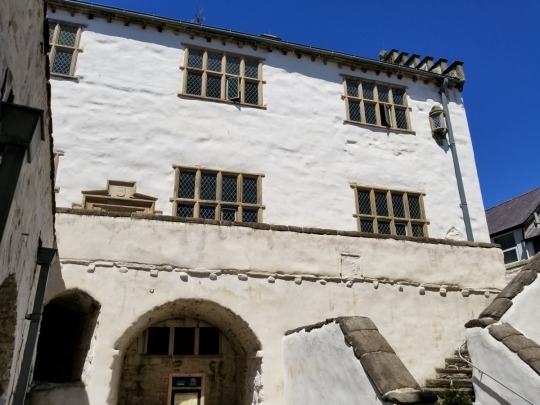
After lunch, we checked out the Elizabethan Plas Mawr house--one of the oldest buildings still standing in Conwy and the first house that a Welshman was allowed to build inside the town walls. (After all, the walls were originally built specifically to keep the Welsh out.)
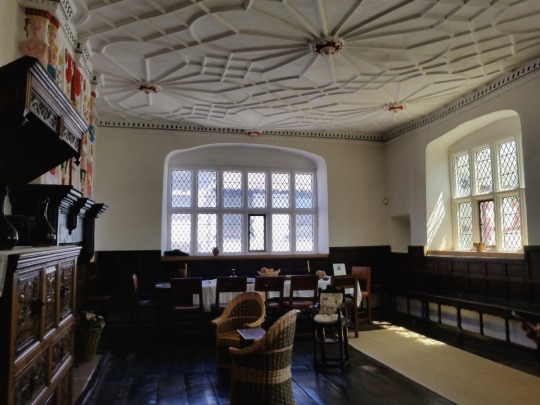
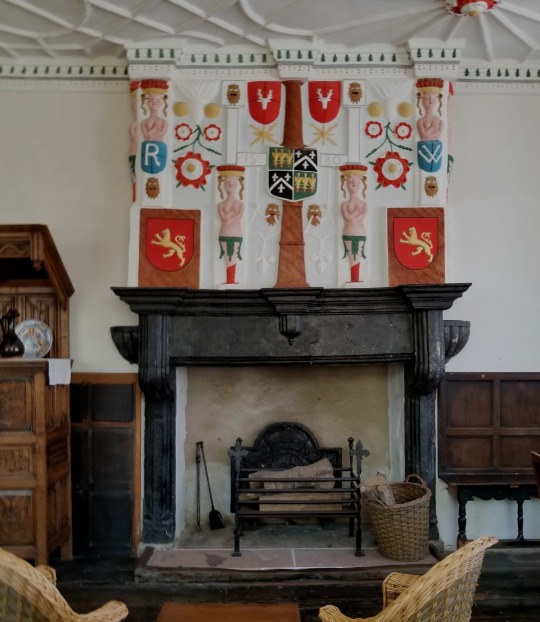

Keeping in mind that the house is almost 500 years old, it’s in remarkable condition. It is filled with interesting plaster and woodwork throughout. We could appreciate what they were going for, but to be brutally honest the craftsmanship and engineering skills just weren’t quite there.



In one room, the plasterwork ended up getting cut off because they didn’t think to double-check the measurements of the room.
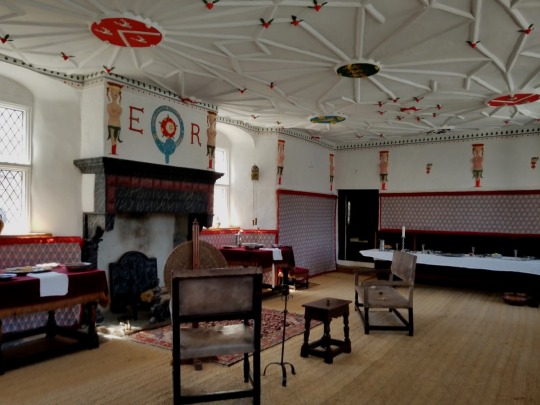
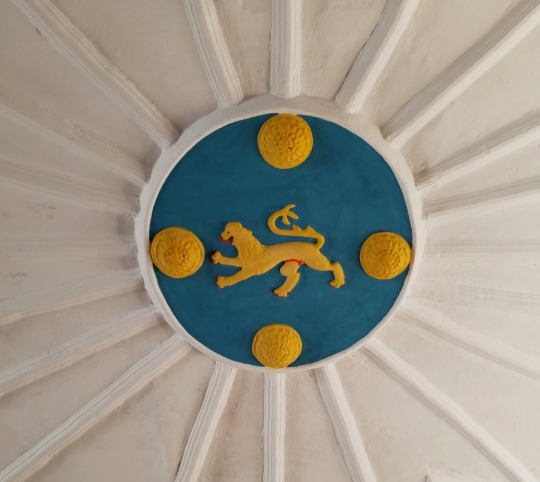
The nude woman used in the plaster motif was apparently based on the artist’s wife, and the fireplace of the great room was painted to look like marble.

Allegedly.
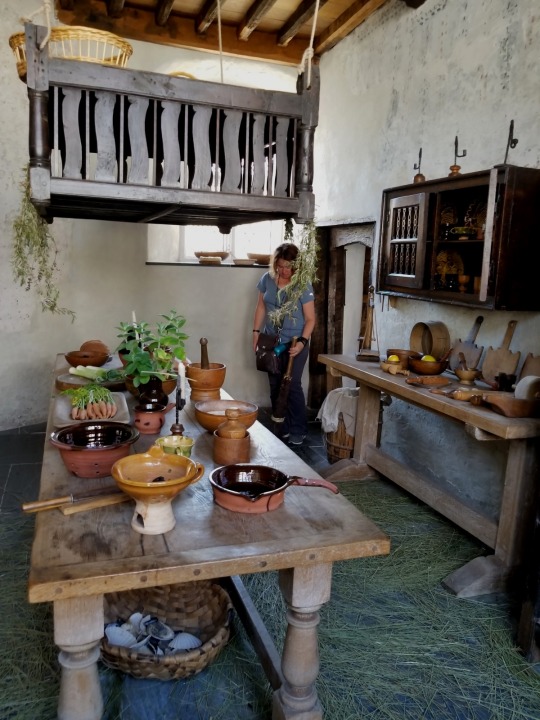


The house’s kitchen was unique in that it was actually stocked with real food and spices (apart from the bouncy foam eggs), and everything wasn’t glued down to the table. It gave the place a remarkably more lifelike and homey feel than the kitchens in other preserved homes and castles we’ve visited--not least because it actually smelled like a kitchen.
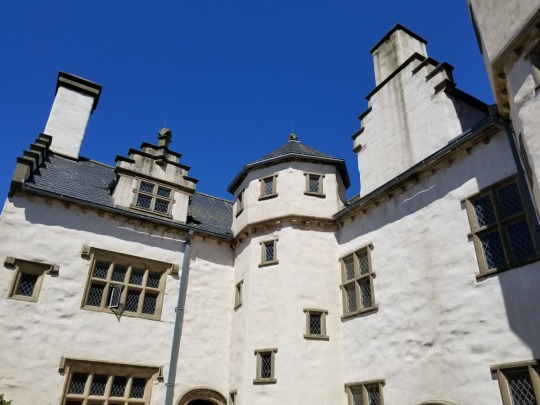

Before we headed upstairs, the delightfully pattering audioguide lead us out for a quick view of the garden. As an aside, Welsh might be my favorite of all the British accents. Jessica was pleasantly surprised by how similar it is to a Scouse (Liverpool) accent--though it makes sense in retrospect given how close the city is to Wales and how much of the city’s population is descended from Welsh immigrants.
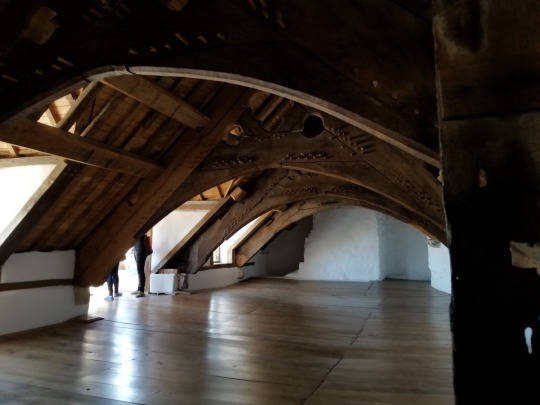
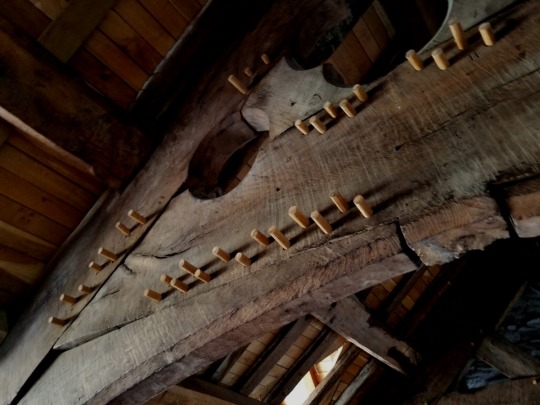
Upstairs, we saw the attic and the house’s arched roof supports with pegged joints. This would have been considered high-tech architecture at the time, and the owner had originally intended for the roof to be on display over the great room below. But he ended up having to add an attic floor for structural reasons.
From the window, we were able to get another great view of the castle and the rest of the town.


And we just couldn’t get away from the California connections.
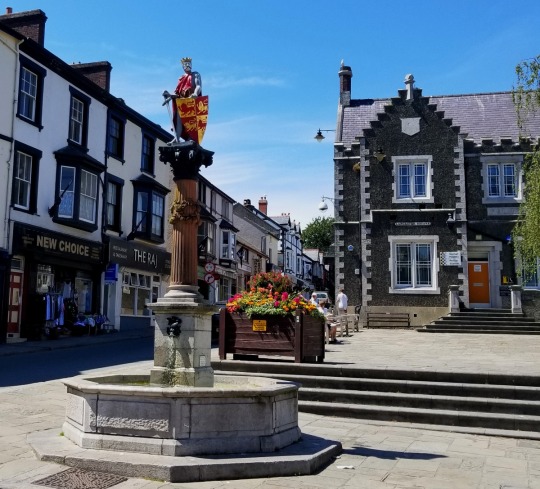
After leaving Plas Mawr, we were tired, hot, and almost ready to go. But I had one last item on my Conwy checklist--walking a section of the wall.
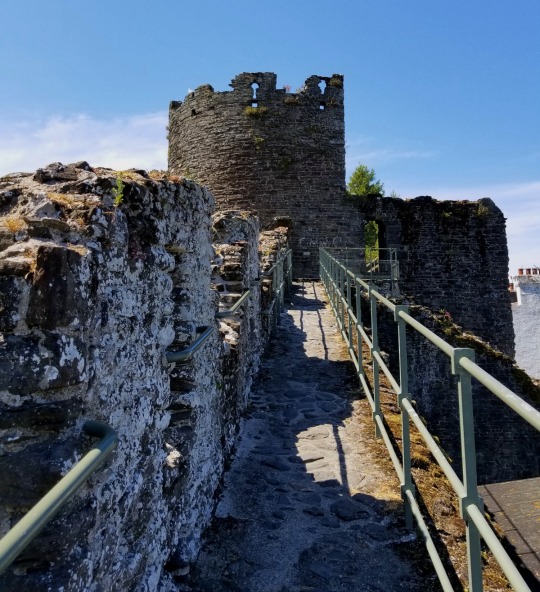

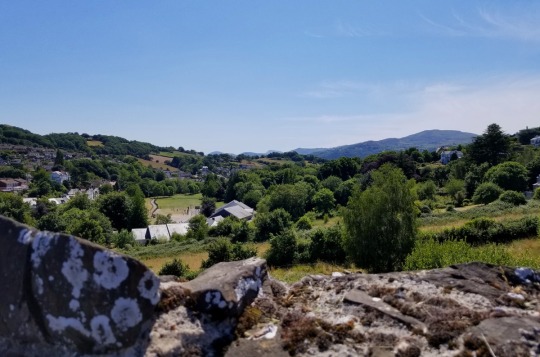


We got off the wall just in time to catch the bus back to Betws. On the way, our driver pulled up outside a school and got out. We ended up waited around thirty minutes while the bus filled up with schoolchildren. Apparently this was a combination city and school bus. Still, it was an interesting experience to hear how school bus banter doesn’t really change no matter where in the world you go--just the accents.
Back home, we picked up dinner from the Spar mini-mart and watched Iceland heroically not quite make it to the next round of the World Cup.
Next Post: Betws-y-Coed & Blaenau Ffestiniog
Last Post: Snowdonia
1 note
·
View note
Text
SOCIOLINGUISTICS OF THE ENGLISH LANGUAGE: CHARACTERISTICS OF “INTERNET ENGLISH”- PART ONE: THE MEME
We would at first like to more closely observe the widespread phenomenon of the meme. The term was first coined by Richard Dawkins in his book “The Selfish Gene”:
We need a name for the new replicator, a noun that conveys the idea of a unit of cultural transmission, or a unit of imitation. 'Mimeme' comes from a suitable Greek root, but I want a monosyllable that sounds a bit like 'gene'. I hope my classicist friends will forgive me if I abbreviate mimeme to meme. If it is any consolation, it could alternatively be thought of as being related to 'memory', or to the French word même. It should be pronounced to rhyme with 'cream'. [DAWKINS, 1976]
While it is highly doubtful that Dawkins intended for this term to become so popular, it is not by definition far from what the famous internet memes are. Nevertheless, it is possible that they are simply called memes due to the French word (not unlikely, given the “relatable” factor that goes into memes), and the above study has simply been connected to it due to its more academic roots.
One way or the other, one could without much effort conclude that a meme is a piece carrying cultural reference, be it old or new. It is oftentimes said that the internet meme is the Web Community’s “inside joke”. Once that thought is given consideration, the definition of a meme as an inside joke makes the most sense of all.
The understanding of memes requires understanding of context, or at least of the fact that this or that piece of culture has acquired this status. Given the internet’s fast-paced world, some memes fall into oblivion fairly quickly, while some remain strong in the internet’s subconscious. Because of that, it is fairly easier to point out which have had a long lasting effect, and are here to stay- at least online.
Interestingly enough, the ephemerons nature of the internet meme has prompted the creation of several website dedicated to keeping track of them, be it widespread or extremely obscure.
Website knowyourmeme.com relies on search engines, collocation examples and history of memes online. There, one can easily look for memes that have directly affected speech patterns of teenagers, both online and between one another. Here are some characteristics shared by most memes that rely on language, a category which includes incessant repetition of seemingly random phrases, words or symbols; interaction between two texts, and a slight change in definition of commonplace expressions.
1.
FLEXIBILITY
Having apparently come from a faux celebrity twitter account, the sentence “I came out to have a good time and I’m honestly feeling so attacked right now” soon exploded online- and, since then, it’s been adapted into numerous situations and different contexts. Here are some examples:

Source: http://i3.kym-cdn.com/photos/images/original/000/785/428/2d3.jpg Visited in 14/03/2017.

Source: http://i1.kym-cdn.com/photos/images/original/000/785/423/466.jpg Visited in 14/03/2017

Source: http://i2.kym-cdn.com/photos/images/original/000/796/293/bb5.pngVisited in 14/03/2017
From looking at these images, one can conclude that this specific phrase has been separated from its original source and applied to numerous contexts familiar to the intended audience. The humor, then, is in the challenge of applying this phrase to any situation. It is, above all, an exercise of reference crossing and inter-textual thinking.
What one can see from examples A, B and C is the common use of elements from pop-culture, historical relevance, and contemporary matters. It is fairly easy to understand their referencing to, respectively, the Harry Potter series, the assassination of Archduke Franz Ferdinand, and the demotion of Pluto’s status as a planet (which has, since then, been reestablished).
2.
META-LANGUAGE
In early 2016, a meme featuring everyday words carrying trademark symbols emerged online and instantly came into everyday use. The popularity of the meme seems to have arisen from the way it takes advantage of the ™ symbol to suggest a corporatization of the word to which it is added. Because it usually stands for a brand, adding ™ to the end of words or concepts gives it a sense of false authority, or, in some cases, of someone or something acting exactly how it is expected of them (stereotypically speaking); so much that it has become a concept to be patented and sold.
E.g.:

Source: http://life-goes-on25.tumblr.com/post/143350223380/alexthefuckingfeminist-bug-free-season-is-over Access on March 19th, 2017

Source: https://www.tumblr.com/blog/onlinelingo. Access on March 19th , 2017
From both these instances, one can visualize a pattern. In the first example, the trademark used after “Bug-free” accentuates its functional nature, as if winter- the season they are referring to- was brought to us as a courtesy of Bug-free™.
Now, on the second example, the uses of the trademark are stretched even further when a clear parallel is drawn between straight people and what the OP calls a particular brand of straight people who feel the need to advertise and promote their heterosexuality. It is also interesting to note the use of capitalization, which separates people who are straight from Straight People, the brand.
The third commenter seems to illustrate this difference with the use of “the” as a marker. By referring to a particular brand of white gay people as the White Gays, the user is talking about a group of gay people that has “whiteness” as its primary qualifier, and to which the subject is attached. “White people who are gay”, or “Gay people who are white”, on the other hand, are sentences whose build suggest an afterthought, therefore forming, as opposed to subjects, predicates.
What is interesting in this whole linguistic process is how much words can challenge and tear meaning apart in the online world. The addition of the trademark symbol is more than playful mockery; it is an open criticism of the empty status some words seem to have acquired. The fact that we need a marker to tell the empty brand from the serious meaning of a word must indicate something about our society- although, this is not something we should be getting into.
Ultimately, the point seems to be that ™ indicates irony at its fiercest form- the word has been through various states, from subtle and airy to icy, but it has finally come full circle and completed a 360. All in all, the word seems to be the same, and yet we know it just came straight from being ressublimated, lighter and not quite as meaningful as before.
This is why we have pointed out meta-language as one of the most frequent and, dare I say, essential characteristics of the word-based meme. Whoever uses this newfound resource of irony is actively exercising meta-language even if through one word, for this word is aware of itself and the context in which it’s situated, and the word itself is a parody of the meaning which it conveys. If intertextuality needs meta-language in order to work, meta-language needs only a self-aware text which allows for “intra”- textuality.
It’s been said that memes like proverbs become clichés after a while, but the point of a meme has always been to become a cliché. A successful meme is, effectively, one that is repeated, imitated- mostly, due to the logic consistently present in its absurdity.
While it does seem like a ridiculous thing to write, memes are transcendental in that which makes the meme completely aware of its absurd nature, so that mockingly we shelter it in language.
3.
METAPHORICAL SWITCHING
Metaphorical switching, according to Fishman, is a sudden shift in variety in the middle of a conversation. This can be in order to create emphatic irony, confusion, or simply emphasis. In late 2015, a meme on Tumblr took advantage of the humorous potential of this phenomenon- by creating the "me, an intellectual" meme (here’s a compilation our team has organized).
Not only does this meme aim to point out the dissonance between high and low prestige varieties, it also works, inadvertently, as a means of social criticism. In its most realized, the "me, an intellectual" meme mocks academic jargon and Oxford English by insinuating that elitism. Let us take a look at some examples now.
I1
You: chill, bro
Me, an intellectual: please allow your core body temperature to decrease, my sibling.
I2
You: What's new scooby doo
Me, an intellectual: what is currently occurring scoobert doobert
I3
You: Burger King
Me, an intellectual: sandwich monarch
In I1, we can observe the metaphorical switching of an informal phrase, "chill", meaning to "cool off" (temper-related). By switching to "decrease your core body temperature", OP is taking an idiom which does rely on some level on real life scientific facts (cool off=calm down), and resublimating it to the descriptive literalism of scientific terms, along with an exaggerated academic vocabulary. Observe how the "intellectual" speech is riddled with latin derived words. That is because for two centuries French was the only language allowed to be officially spoken in England, which led to other French- related varieties of already existing words. These varieties were descendant from Latin and were more associated with noblemen and higher classes, whereas the common people went on using the words derived from Old English (descendant from the Anglo-Saxon). This divide remains even nowadays, which explains why Latin sounding words are more academic and everyday vocabulary is still mostly originated from Anglo-Saxon. See, for instance, the similarities of the English word "hound" and the German word "Hund". More abstract concepts, however, like "example", derive from the French "Exemple". In German, this word is completely different (one would say "Zum Beispiel").
In I2, the dissonance between the first and second sentences relies on a Pop Culture reference- namely, to the song in the opening credits of the Scooby Doo cartoon. When OP changes that recognizable reference, it makes absolutely no sense. This occurs mostly due to the phrase's symbolic weight and the subsequent disregard the second one has for it.
Likewise, in I3, one would have to understand the reference to fast food chain Burger King- hence, why it would be ridiculous to refer to it as "Sandwich Monarch". This might be the most critical of the three instances, because it reaches an entirely new level of elitist absurdity.
-------------------------
Part (2)
Part (3)
Read the full series: O
#our series on internet english#part one#1#meme#a Meme™#tumblr meme™#trademark meme#me an intellectual#i came out to have a good time
17 notes
·
View notes
Text
I'm actually soing my thesis on elves!
Re: origins, the most accepted theory is the one with *albho- for brightness. There's another hypothesis (actually the only theory cited in the Oxford English Dictionary, even though it's more of a stretch) that links them to Vedic deities through the word *rbhu (with a sonant r, but I'm typing from a phone). See Kazanas for a paper on the subject, I believe it was called Indo-european deities and the Rg Veda.
As for svartalfar and such: kee in mind that the main source of that classification is Snorri Sturluson, who was writing from a Christian perspective and trying to make elves more similar to angels and devils. There is no mention of dark elves in earlier Scandinavian sources.
Most early Scandinavian evidence points to elves being seen as minor deities, possibly linked to fertility and prosperity. They received some sort of sacrifice (not much detail on this in Skaldic poetry, but an "alfablót" is mentioned once and Kormaks saga talks about pouring bull's blood on a mound where elves live) AND were linked to the sun through the poetic metaphor alfrodhull (literally "elf's wheel" or "elf's glory", meaning sun. Again, missing accents here, sorry). Human warriors and kings were also described as metaphorical elves in poetry, most notably Norwegian king Olafr Geirstadhalfr "the Elf of Geirstadhir", named after his burial site, who was also sacrificed to in order to secure prosperity.
Also, the meaning of alfr (the Old Norse elf) is a lot less clear than it looks. It was probably not a "race" of beings as we might conceptualise today. More likely it had a range of meanings, possibly as wide as "any being capable of giving supernatural blessings" or at least "any semi-divine creature". Medievam folk did not have a concept of taxonomy and as such did not classify things the way we do.
In the elder Edda, elves are routinely paired with the Aesir in poetic formulae, possibly with the meaning of "all divine creatures, from gods to elves". In at least a few songs (esp. Lokasenna) they seem to be synonymous with the Vanir (Freya is said to have slept with "all Aesir and elves", which Loki says is incest, apparently because she's an elf and her brother is too?). Freyr especially is linked to the elves through Alfheimr, the elf-realm which he is said to have been gifted with. This association is however not present in other songs, where vanir and elves are mentioned side by side as though they were different groups (see for instance Skirnismal and Alvissmal).
The only elf character in the Edda may be Volundr, who is said to be alfa ljodhi (ambiguous, possibly "of the elf-people") and visi alfa (leader of the elves)in Volundarkvida. This is weird because Volundr is a very popular character with equivalents in Anglo-Saxon Weyland and German Wieland, but this is the only source calling him an elf. Here the term may have been a way to classify him as an ethnic Other (being a Sami prince) and carries implications of dangerous beauty. There's a very good paper on him, called The extreme emotional life of Volundr the Elf.
The earliest of these sources date back to the Ninth century. Note that nowhere are elves described as being specifically diminutive in size, invisible or whatever. That is likely the product of later shifts in meaning or belief, possibly linked to Christianization and merging with other supernatural beings, such as dwarves (as in the aforementioned svartalfar, which are described as being black as coal and are also apparently dwarves, at least according to Snorri), and landvaettir (nature spirits). Terry Gunnell has done a lot of work on this, check out How Elvish were the Alfar? (2007).
Anoyher good source is the work of Alaric Hall, esp. Elves in Anglo-Saxon England (2007). The book focuses on old english but also goes over Scandinavian evidence.
Might share more sources later once I get to my computer if anyone is interested.
elf
Elves are fun because there are so many vastly different interpretations. Everything from Santa's toymakers to Elrond and his court qualify into our concept of elven forms.
Generally speaking, we might define elf as being a "spirit, sprite, fairy or goblin; some kind of usually mischievous supernatural creature." This same definition existed for the Middle English term elf, alternately recorded as alfe or elfe. In Old English, the word was ælf, still retaining its meaning of "sprite, incubus or fairy," but specifically with a masculine connotation. The feminine version of the word was ælfen, which interestingly is the predecessor to our modern adjectival form elven.
The word branches out of the Germanic family, and we can point to some other connected words in Old High German, like alp which meant "nightmare." There is actually an Old English cognate which is ælfádl, also meaning "nightmare," but more literally, "elf-disease." Another interesting elf-induced sickness was though to be hiccups, which is reflected in the OE translation ælfsogoða.
Beyond this era of the Old English and German there is some debate about where the words originally sprouted from. The trail may be related to albus or alphoús ἀλφούς, the Latin and Ancient Greek terms for "white" respectively. The cultural theory implies that elves were considered beings of light, brightness and beauty, and thus as this concept evolved from those ideas, so did the English form out of the adjectives.
74 notes
·
View notes
Text
Prompt A: How has our conception of “the city” changed throughout history?
There is so much about the modern city that has changed. When we look at how our cities have changed in the last 50 years, we cannot escape the conclusion that our physical surroundings must have had a part to play in this decline. Post-war buildings and planning are the product of the failed modernist ideal that transformed most aspects of twentieth-century life, from politics to painting, and that gave rise to our urban social ills and to urban ugliness. In architecture, modernism—the cult of abstract rationality and change for its own sake—has given us sterility and inhumanity instead of its promised progress and liberation. Utopian ambitions and professional arrogance have left our cities with decay and dereliction, the perfect breeding ground for the alienation and brutality that have undermined community life.
Some of us look to the cities we admire from the past for a solution. In traditional cities like Siena in Italy or Bath in England we can see something that is not only beautiful but alive and humane, the very qualities that modernism seems to have destroyed. One can't help feeling we could make our cities more life-enhancing if we were to build them like these traditional cities. Out of this impulse, a revival of traditional architecture and city planning has grown up; it is flourishing from Portland, Oregon, to Paternoster Square in London, from Brussels in Belgium to Seaside, Florida.
We call the places that have inspired this movement traditional, but, other than the simple fact of being old, how do we define a traditional city? I must confess that I do not know.
But the question is do any of us know really know? We talk about tradition and cities as if we all knew what these things were, and we make comparisons with the past on the assumption that we really can do something similar today. But what hope do we have if we are not even talking the same language?
The word "city" is derived from the Latin for citizen and originally meant a community of citizens. It does not mean that now. Any comparison we make with classical antiquity must also acknowledge huge differences in size. The average population of a pre-Hellenic Greek city would be a little over 5,000. A large provincial Roman city would have a population of 10,000 to 20,000. Not much changed in terms of size until the Industrial Revolution. Most medieval cities had fewer than 10,000 inhabitants. Even major Italian Renaissance cities rarely exceeded 50.000. Today, London counts 8 million inhabitants, Chicago contains nearly 3 million people, Paris 2.5 million, and even a small Italian city such as Perugia has a population of 120,000.
These differences in size make for very different dynamics of city life. So, too, do differences in social and political organization. Democracy in Greek city-states or Italian communes was unlike modern democracy and was a fragile flower easily and often crushed. Throughout the history of the city, it was much more common to be subject to oligarchic or tyrannical rule.
Equally crucial to an understanding of the city is its economic base. Very early cities were fortified villages where people engaged in agriculture outside the walls. This did not last for long. Since antiquity, the city has been a consumer of goods produced in the countryside. It supported itself on trade or conquest. A city was a place where wealth free from the pressures of sufficiency could be enjoyed. Outside the city there was brute existence, the wilderness, the struggle for survival and danger; inside the city there was order, safety, wealth, and the leisure to pursue the finer things of life. This urban ideal may have been the lot only of some citizens, but it embodies the essential ideas that made the city a civilized place.
This ideal of civilization, however, is at odds with the modern concept of the city. The modern city is the wilderness, the urban jungle. The inner city is a dangerous place where brute existence is dominated by the struggle for survival. Anyone with sufficient wealth leaves the public city for a private place where there is safety, order, and the enjoyment of leisure.
In so many ways, the modern city is not the city of the pre-industrial past. The population, the social structure, the political organization, the economy, access to and from the city, and even the concept of the city is quite different. Above all, the citizen is a radically different creature. Modern aspirations and the understanding of citizenship have little similarity with any period in the past.
If all this does not define what a traditional city is, it certainly defines what a modern city is not. It is not an ancient Greek, medieval, or Renaissance city. We may wish to make it more like one of these, like part of one of these, or an amalgam of these types of cities, but to do that we must understand who will live in it and how they will live.
What has happened to all these people who no longer live in our city centers? They live in the suburbs.
As with the word "city," we have to be careful with the word "suburb," which originally referred to the place "suburbs"—below, under the power of, or just outside the city. As the population of cities has exploded in the last two centuries, and ever more people have spilled out into suburbs, "suburb" has come to mean a quite separate environment with its own way of life.
In fact, it can mean different things in different countries. In southern Europe, where denser patterns of living are acceptable, suburbs tend to be recently built, unregulated areas, no less dense than city centers. Often it is the suburb that is undesirable and dangerous and the city center that is desirable.
In northern Europe—and particularly in Britain—and in the United States, Canada, and other countries sharing an Anglo-Saxon inheritance, suburbs are quite specifically low-density areas of individual dwellings, each with its own lot. They cover large areas and sometimes, but not always, are a dormitory area for a city. In the Anglo-Saxon and
American world, unlike parts of southern Europe, it is the suburb that is usually desirable and safe and the city center that is undesirable and unsafe.
In southern Europe, suburbs often have arisen solely through population pressure. In the Anglo-Saxon world, they developed with the spread of railway travel and then of the motorcar, and were enthusiastically adopted.
The Anglo-Saxon suburb grew out of a very clear set of ideals. It began in England, where the social pattern of urban life is unlike that of most other European countries. The ruling aristocracy never really took to city living, and as a consequence English culture to this day is defined more by the country than by the town. The idea that to have your own house in the country is the best of all worlds is the Anglo-Saxon suburb's founding principle. Improved transport, the uncontrolled migration of rural workers into city slums in the Industrial Revolution (which affected Britain long before anywhere else), and the rapid increases in population and wealth that went with it, drew more and more people into the Industrial Age's version of the countryside—the suburb.
In the United States, the founding fathers (Hamilton excepted) inherited the English view of the countryside. When this ideal was added to the New World enthusiasm for the wilderness, the tradition of pioneering isolation, and the cult of the individual—and as the population grew unfettered by loyalty to historic towns-living in a suburban way seemed irresistible. In Britain and the United States, whole towns—Muncie, Indiana, for example, or Letchworth in Herefordshire—now conform to the suburbian model.
In one sense, both the Anglo-Saxon and the American suburbs have been a great success. Each household has its own lot where the individual or family can reign supreme, untroubled by the antisocial acts of others. The suburb answers one of the great social imperatives of the last two centuries—the increasing demand for privacy.
This demand for privacy can be traced through individual house design, mass housing design, and law. It extends from the detached house to the individual child's bedroom and to the proliferation of bathrooms. It has been enhanced by the private motor vehicle, the telephone, the television, and now the personal computer. In Britain it is being extended into laws on domestic noise and garden fires, and in California (always ahead) to smoking and even personal fragrance.
If we are to build cities today in the United States or in Britain, and if it is to be more than a minority exercise, we will have to design for the citizen who is now suburban or at least yearns for suburban amenities—for the citizen who will demand a level of privacy and will possess the technological means of isolation unknown to any citizen in history. We can no longer build on the classical ideal of the subordination of the citizen to the community. Suburban values are middle-class values, where the family and the individual take priority.
So building traditional cities, traditional modern cities, we have an interesting dilemma. We would not do this unless we thought it was a good thing. We must think that the city can be a desirable place, and yet the popular Anglo-Saxon and American concept of the city contains much that is undesirable. We can only think that the city is desirable because we have an ideal that differs from 112 the way that modern cities have developed. If the ideal is traditional and so necessarily historical, we know that in many respects it will not fit with present realities.
If it is our desire to reconcile the ideal of the traditional or historical city with the realities of modern life, we must realize that we will not be re-creating the past but creating something new. In doing so, we must first look beyond any superficial resemblance to the essential and desirable characteristics of the historical city that are missing from the modern city and then seek a mechanism for their introduction into a modern context.
Source: The Social Order, Tradition and The Modern City. Robert Adam 1995
Furthermore Many cities grew in a process called urbanization which is the process of making an area more urban. Many people have left the life they had of poverty and economic vagary in the countryside and moved to “the city” for the promises of jobs and more opportunities. However, the cities were not prepared for the sudden arrivals of many new people which means that were overcrowding housing in addition to primitive sanitation, which cause the city to be the sites of major public health epidemics. the 1793 yellow fever outbreak killed 5,000 people in Philadelphia. In 1849, St. Louis lost 1/10 of its population to cholera. Four years later, yellow fever killed 11,000 in New Orleans.
One concept that Americans had 50 to 60 years ago about the city does still somewhat stand to this day and that’s the city is still better in many way. Most people tend to move out to the city such as New York City in search of better jobs, more opportunities, more freedom etc, especially if they tend to come from a small town.
1/17/2017
7 notes
·
View notes